SPECIAL TOPIC— Quantum transport in topological materials and devices
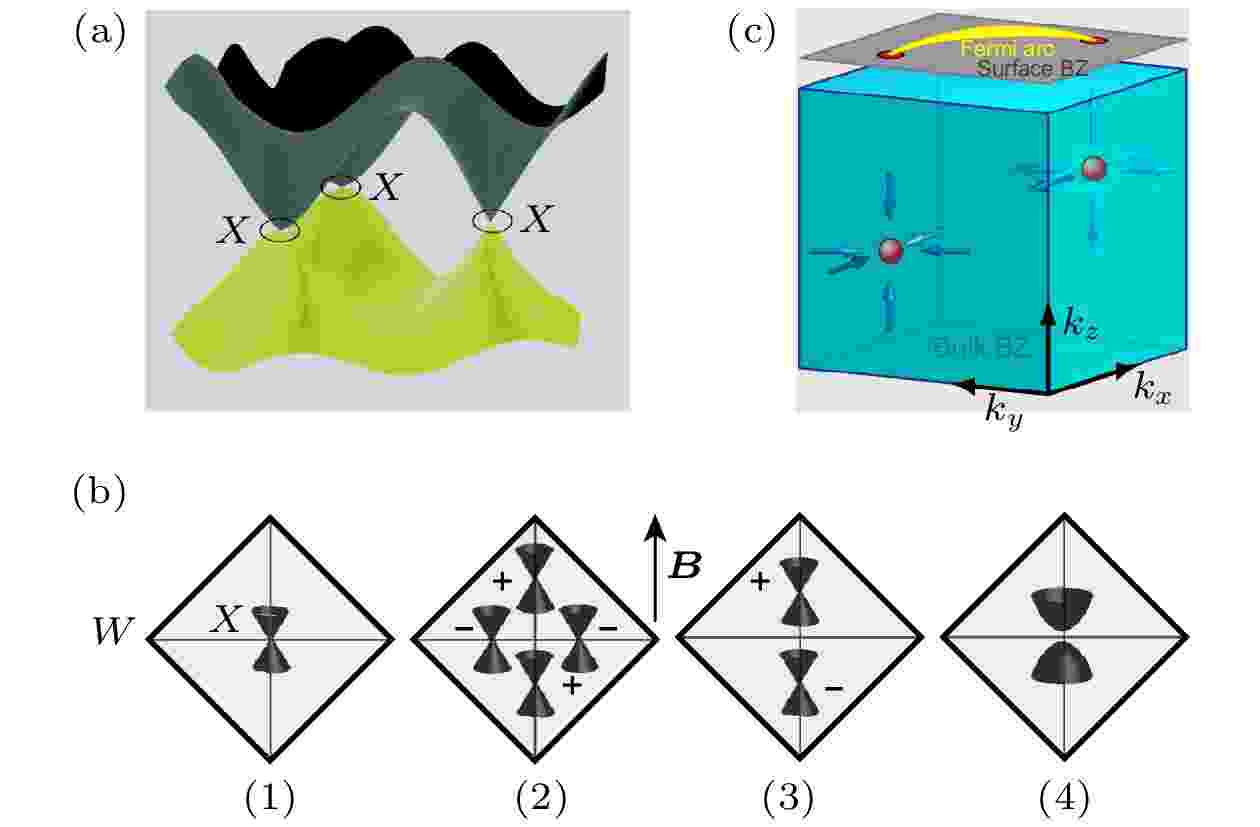
EDITOR'S SUGGESTION
2023, 72 (8): 087401.
doi: 10.7498/aps.72.20230397
Abstract +
Topological semimetals are exotic phases of quantum matter with gapless electronic excitation protected by symmetry. Benefitting from its unique relativistic band dispersion, topological semimetals host abundant quantum states and quantum effects, such as Fermi-arc surface states and chiral anomaly. In recent years, due to the potential application in topological quantum computing, the hybrid system of topology and superconductivity has aroused wide interest in the community. Recent experimental progress of topological semimetal-superconductor heterojunctions is reviewed in two aspects: 1) Josephson current as a mode filter of different topological quantum states; 2) detection and manipulation of topological superconductivity and Majorana zero modes. For the former, utilizing Josephson interference, ballistic transport of Fermi-arc surface states is revealed, higher-order topological phases are discovered, and finite-momentum Cooper pairing and superconducting diode effect are realized. For the latter, by detecting a.c. Josephson effect in Dirac semimetals, the 4π-periodic supercurrent is discovered. By all-electric gate control, the topological transition of superconductivity is obtained. Outlooks of future research on topological semimetal-superconductor heterojunctions and their application in Majorana braiding and topological quantum computing are discussed.
REVIEW
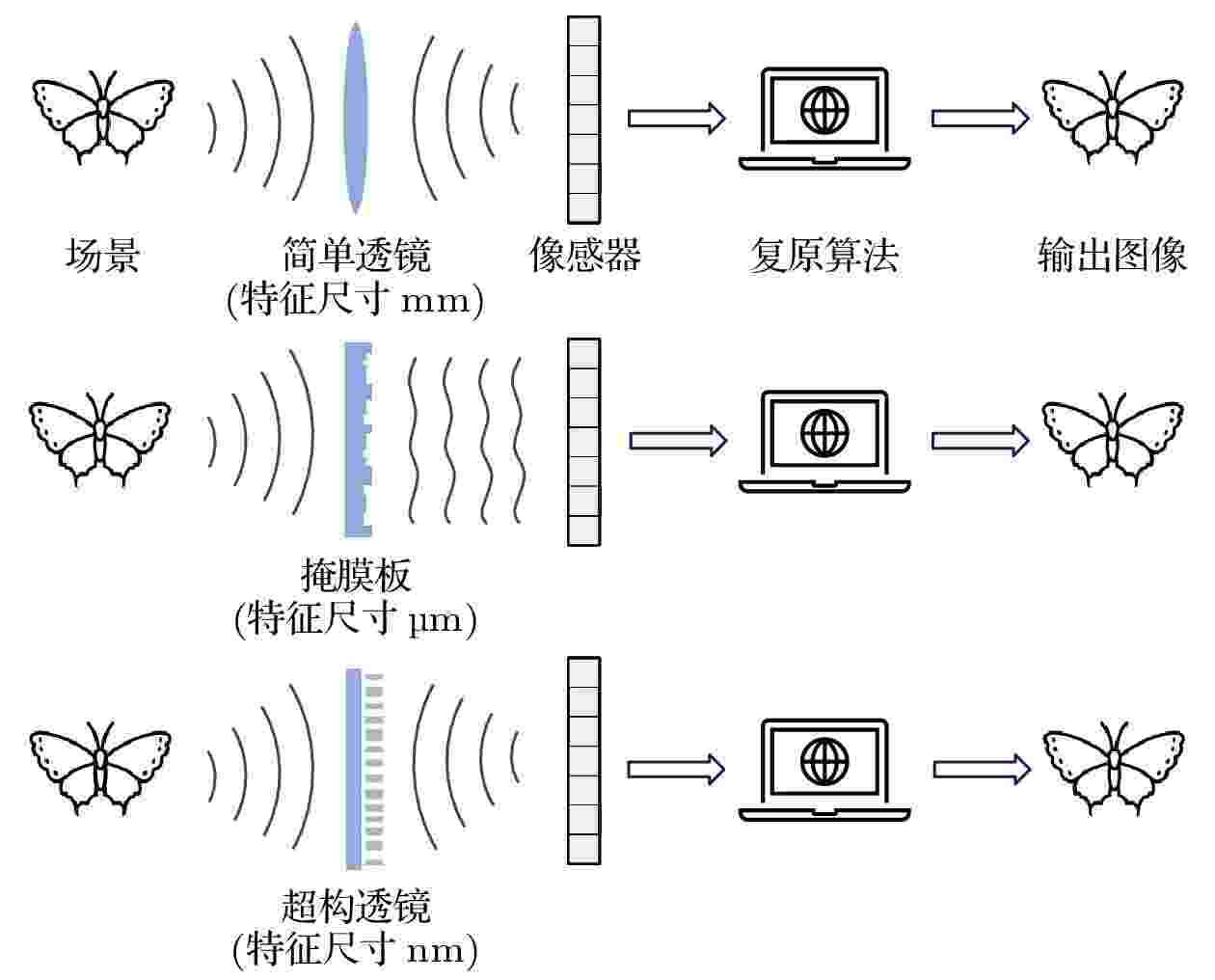
EDITOR'S SUGGESTION
2023, 72 (8): 084205.
doi: 10.7498/aps.72.20230092
Abstract +
Computational imaging enables optical imaging systems to acquire more information with miniaturized setups. Computational imaging can avoid the object-image conjugate limitation of the imaging system, and introduce encoding and decoding processes based on physical optics to achieve more efficient information transmission. It can simultaneously increase the amount of information and reduce the complexity of the system, thereby paving the way for miniaturizing imaging systems. Based on computational imaging, the simple and compact optical imaging techniques are developed, which is also called simple optics. To develop miniaturized optical imaging elements and integrated systems, simple optics utilizes the joint design of optical system and image processing algorithms, thereby realizing high-quality imaging that is comparable to complex optical systems. The imaging systems are of small-size, low-weight, and low-power consumption. With the development of micro-nano manufacturing, the optical elements have evolved from a single lens or a few lenses, to flat/planar optical elements, such as diffractive optical elements and metasurface optical elements. As a result, various lensless and metalens imaging systems have emerged. Owing to the introduction of encoding process and decoding process, an optical imaging model is developed to represent the relationship between the target object and the acquired signal, from which the computational reconstruction is used to restore the image. In the image restoration part, the algorithms are discussed in three categories, i.e. the classic algorithm, the model-based optimization iterative algorithm, and the deep learning (neural network) algorithm. Besides, the end-to-end optimization is highlighted because it introduces a new frame to minimize the complexity of optical system. In this review, the imaging techniques realized by simple optics are also discussed, such as depth imaging, high-resolution and super-resolution imaging, large field of view imaging, and extended depth of field imaging, as well as their important roles in developing consumer electronics, unmanned driving, machine vision, security monitoring, biomedical devices and metaverse. Last but not least, the challenges and future developments are prospected.
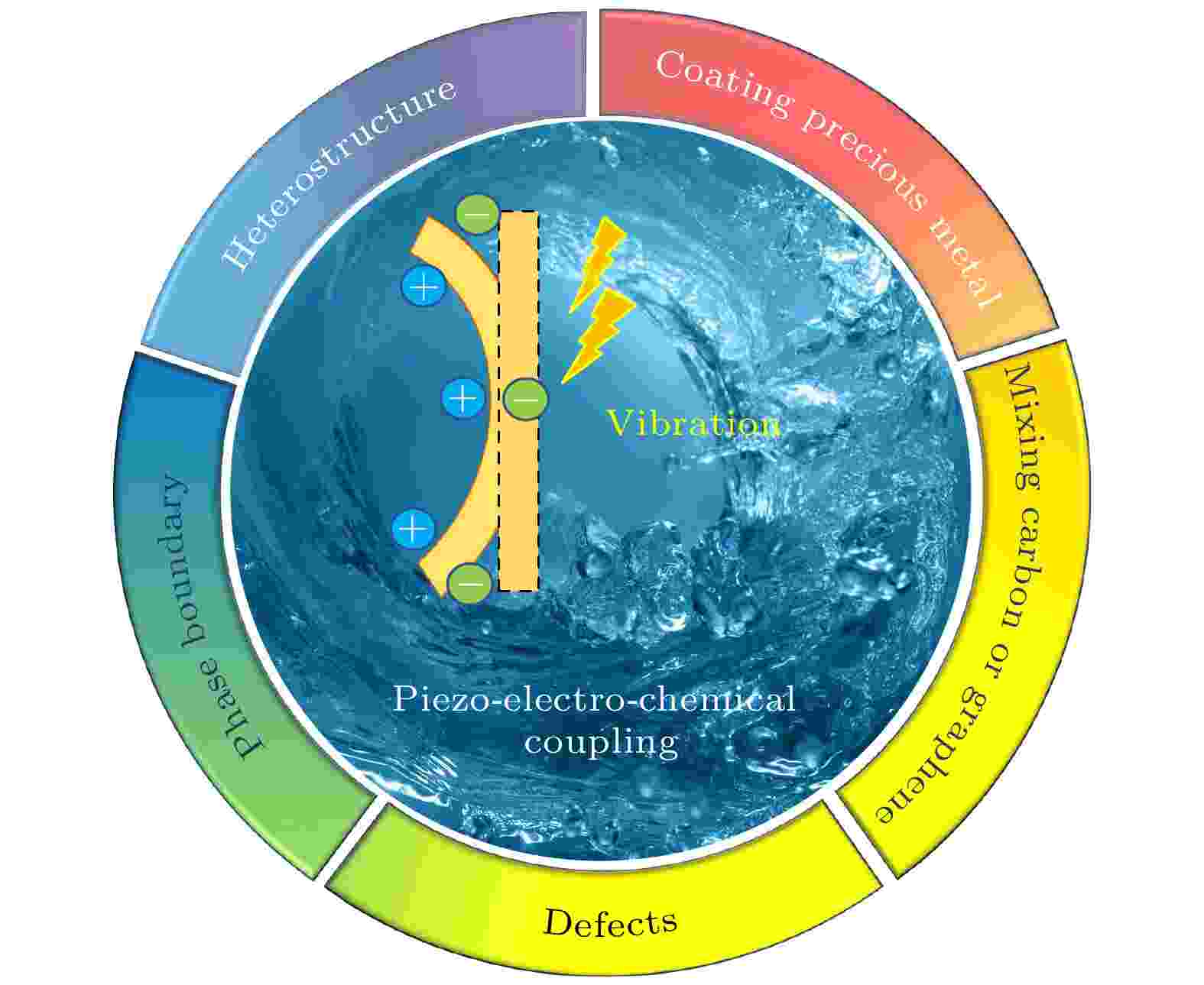
2023, 72 (8): 087701.
doi: 10.7498/aps.72.20222078
Abstract +
Piezoelectric materials can harvest tiny mechanical energy existing in the environment, and have strong ability to convert mechanical signals into electrical signals. Piezo-electro-chemical coupling can be realized via combining piezoelectric effect of piezoelectric materials with electrochemical redox effect. In recent years, piezo-electro-chemical coupling has attracted a lot of attention from researchers in harvesting vibration energy to treat dye wastewater. The piezoelectric catalyst material dispersed in solution is deformed by ultrasonic vibrations. Owing to the piezoelectric effect and spontaneous polarization effects, positive and negative charges are generated at both ends of the catalyst, which can further react with dissolved oxygen and hydroxide ions in the solution to generate superoxide and hydroxyl radicals (·${}{\rm{O}}_2^- $ and ·OH) for decomposing organic dyes. However, ordinary piezoelectric catalytic materials are often difficult to meet people's pursuit of efficient treatment of organic dyes. Researchers have conducted a lot of researches on piezo-electro-chemical coupling, mainly focusing on the following two aspects: 1) the modification of piezoelectric catalysts to achieve extended carrier lifetime, accelerate carrier separation and high piezoelectric coefficients, and 2) the combination of piezo-electro-chemical coupling with photocatalysis to suppress photogenerated carrier compounding to obtain high synergistic catalytic performance. In this work, the following five strategies to enhance the piezo-electro-chemical coupling via modifying piezoelectric catalyst materials are introduced. The heterojunction structure is constructed to promote the separation of electron-hole pairs. The precious metal is coated on the surface of the catalyst to accelerate the transport and transfer of electrons. The catalyst composition is regulated and controlled to obtain an increased piezoelectric coefficient at the phase boundary. Carbon or graphene are mixed in the catalyst to accelerate the electron transfer on the surface of piezoelectric material. The number of active sites increases through introducing defects into the catalyst to increase the concentration of carriers. The physical mechanisms of five different strategies are described from the perspectives of electron transport and transfer, phase transition, and oxygen vacancies. In addition, the prospects for piezo-electro-chemical coupling in energy and biomedical applications such as hydrogen production, carbon dioxide reduction, tumor therapy and tooth whitening are presented.
GENERAL

2023, 72 (8): 080201.
doi: 10.7498/aps.72.20230031
Abstract +
Using physics-informed neural networks to solve physical inverse problems is becoming a trend. However, it is difficult to solve the scheme that only introduces physical knowledge through the loss function. Constructing a reasonable loss function to make the results converge becomes a challenge. To address the challenge of physics-informed neural network models for inverse design of electromagnetic devices, a deep physics-informed neural network is introduced by using the mode matching method. The physical equations have been integrated into the network structure when the network is constructed. This feature makes the deep physics-informed neural network have a more concise loss function and higher computational efficiency when solving physical inverse problems. In addition, the training parameters of deep physics-informed neural networks are physically meaningful compared with those of traditional physics-informed neural networks. Users can control the network by parameters more easily. Taking the scattering parameter design of a two-port waveguide for example, we present a new metal topology inverse design scheme and give a detailed explanation. In numerical experiments, we target a set of physically realizable scattering parameters and inversely design the metallic septum by using a deep physics-informed neural network. The results show that the method can not only achieve the design target but also obtain solutions with different topologies. The establishment of multiple solutions is extremely valuable in implementing the inverse design. It can allow the designer to determine the size and location of the design area more freely while achieving the performance requirements. This scheme is expected to promote the application and development of the inverse design of electromagnetic devices.

2023, 72 (8): 080202.
doi: 10.7498/aps.72.20222230
Abstract +
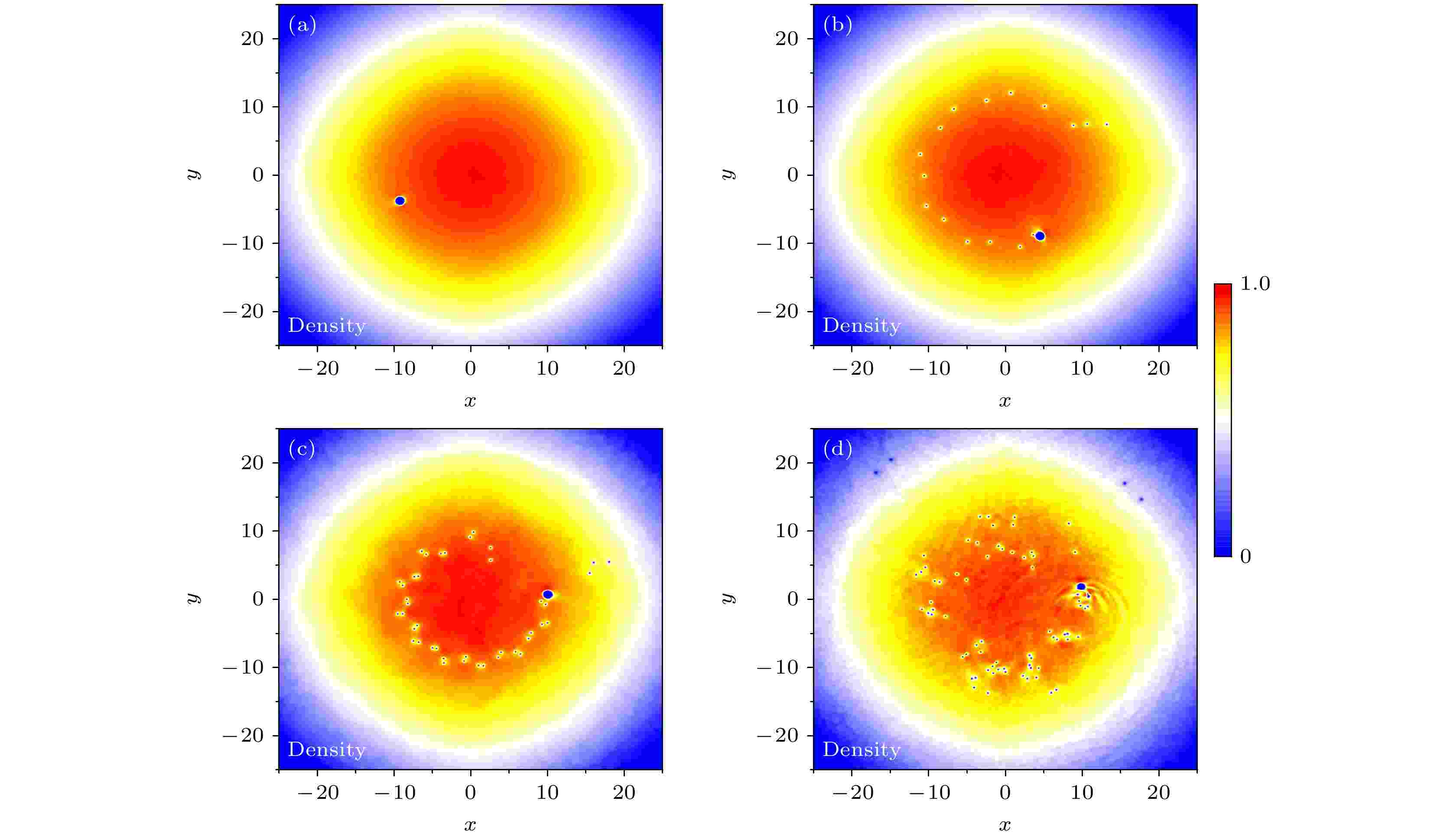
2023, 72 (8): 080501.
doi: 10.7498/aps.72.20222312
Abstract +
The dynamical behaviors of a dipole Bose-Einstein condensate (BEC), which is stirred by a circular moving Gaussian potential, are numerically investigated by using the mean-field theory. In this work, the atom is assumed to polarize along the z-axis. Firstly, the stationary state of the system is obtained by solving the quasi-two-dimensional Gross-Pitaevskki equation numerically under periodic boundary conditions. And then, taking the obtained ground state as the initial condition, the dynamic evolution of the dipole BEC system is studied by the time-splitting Fourier spectrum method. Four types of emissions, namely, the stable laminar flow, vortex dipole, Bénard–von Kármán (BvK) vortex street and irregular turbulence, are observed in the wake when the velocity and size of the Gaussian potential change gradually. When the velocity of the Gaussian potential reaches the critical velocity of vortex excitation, vortex pairs with opposite circulations alternately fall off from the surface of the Gaussian potential. Owing to the interaction between the vortex dipoles, the dipoles rotate around their own centers. Finally, a ring structure will be formed and exist in the wake stably for a long time. With the increase of the velocity of Gaussian potential, the period of dipoles shedding is also shortened. For the appropriate velocity and size of the Gaussian potential, the vortex pairs with the same circulations will periodically fall off from the Gaussian potential and stably distributed on the inner and outer rings, forming BvK vortex street. Our caculation reveals that the conditions for forming BvK vortex street when the dipole BEC is stirred with a circular moving potential are very restricted. When the velocity or size of the Gaussian potential continues to increase, the phenomenon of the periodic vortex pairs shedding in the wake of the Gaussian potential will disappear, and the shedding pattern of the dipole BEC becomes irregular. Using experimental parameters, the parameter ranges of different dipole interactions are obtained through numerical calculation. The influences of dipole interactions, velocity and size of the Gaussian potential on different emission are discussed. In the end, the physical mechanisms of different emissions are analyzed by calculating the drag force acting on Gaussian potential.
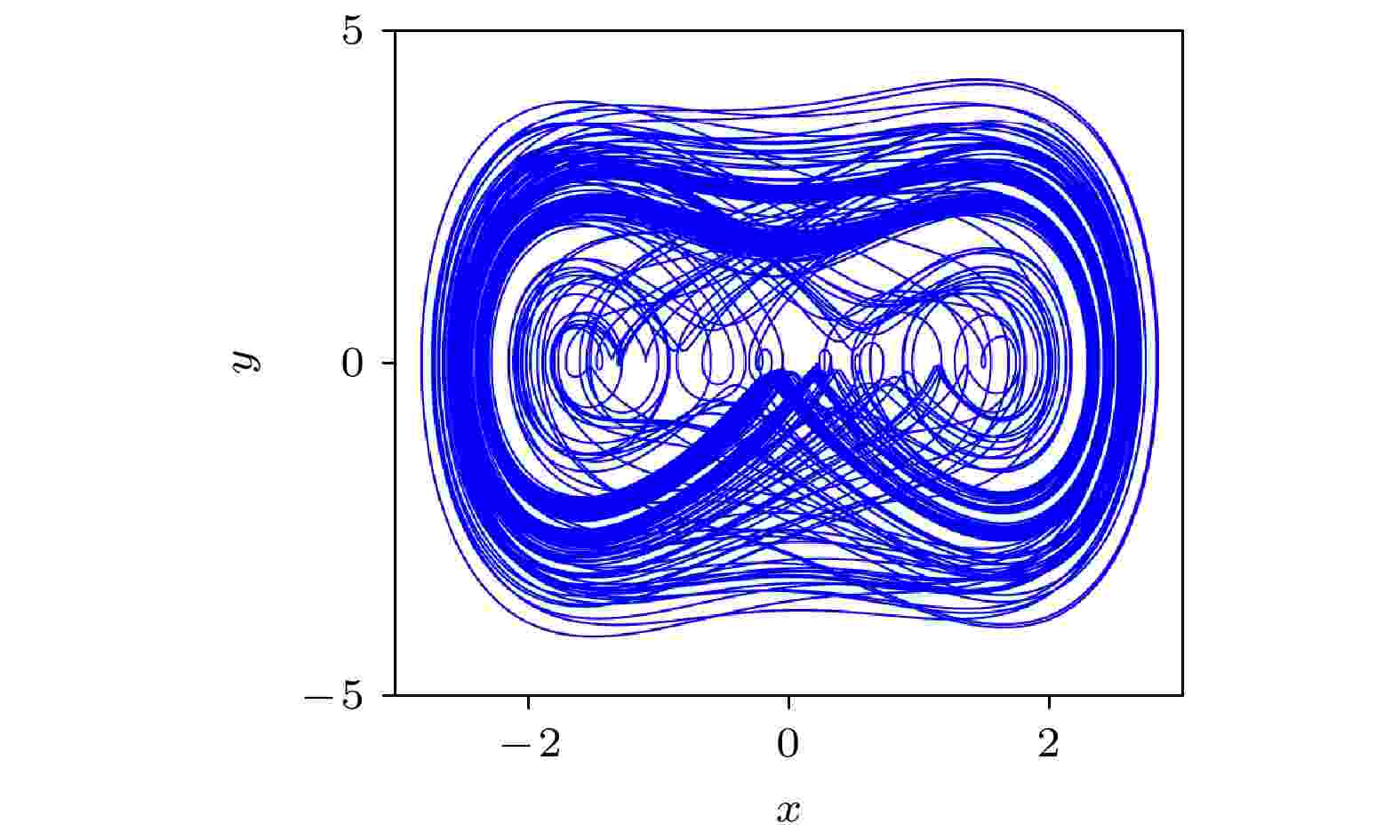
2023, 72 (8): 080502.
doi: 10.7498/aps.72.20222294
Abstract +
Control parameters are frequently subjected to certain restrictions in the engineering practice of chaos control. It is difficult to stabilize multi-rotation unstable periodic trajectory when the stability range is too small and outside the restrictions of control parameters. Thus, it is fundamentally important to expand the stability range of the controlled multi-rotation unstable periodic trajectory by using an applicable method. In this work, the original extended time-delay feedback control is improved based on the time-varying switching strategy, which leads to the time-varying switching extended time-delay feedback control. The time-varying switching extended time-delay feedback control only applies the control to the controlled system in a specific period, and does not apply the control to it in other periods, this is different from the continuous control of the original extended time-delay feedback control. The specific performance of the time-varying switching extended time-delay feedback control in stabilizing unstable multi-rotation periodic trajectories is investigated by case studies. The maximum Floquet multiplier of the controlled periodic trajectory is calculated, and the relationship between the stability region of the controlled multi-rotation periodic trajectory and the switching frequency is obtained. The results show that with the increase of switching frequency, the stability region of the controlled multi-rotation periodic trajectory presents a non-smooth change. In particular, the stability region of the time-varying switching extended time-delay feedback control is significantly larger than that of the original extended time-delay feedback control when an appropriate switching frequency is selected.
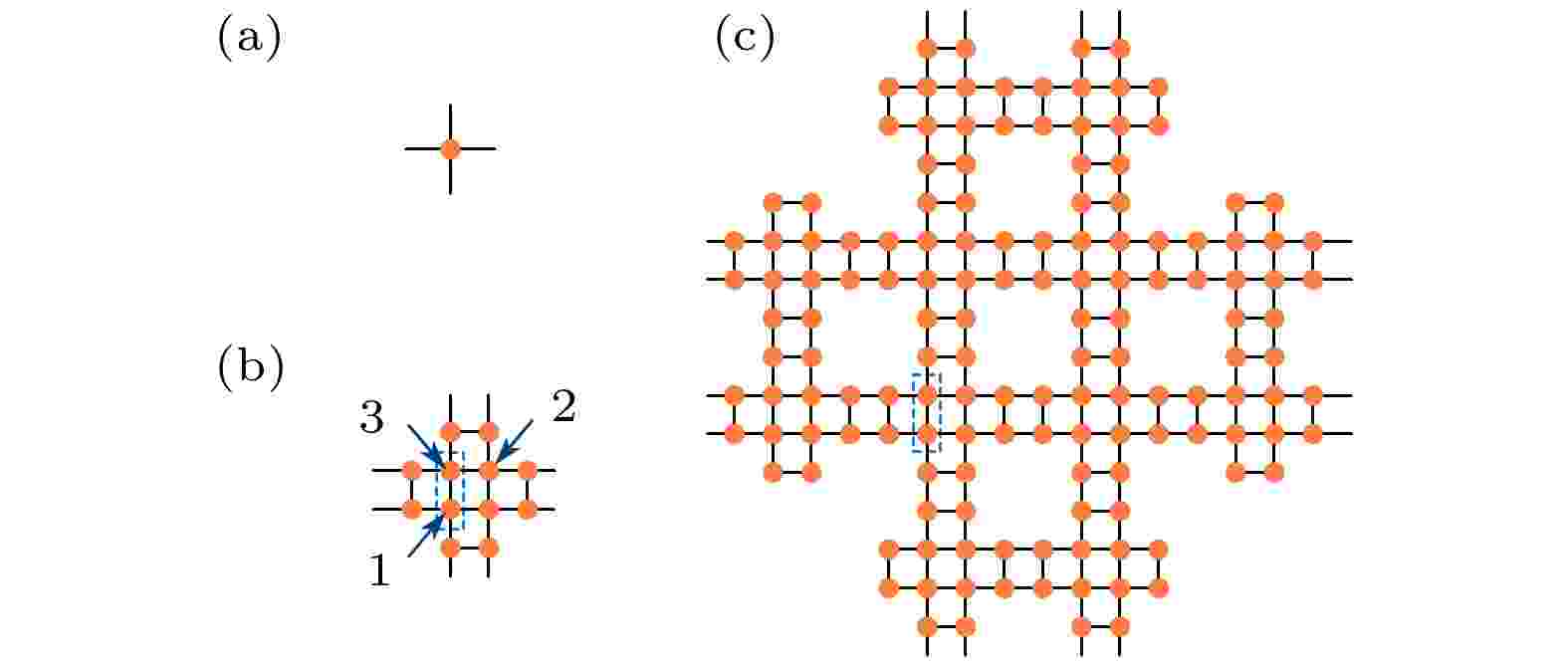
EDITOR'S SUGGESTION
2023, 72 (8): 080503.
doi: 10.7498/aps.72.20222432
Abstract +
Fractal lattices are a special kind of lattice: they have non-integer Hausdorff dimensions and break the translation invariance. Studying these lattices can help us understand the influence of non-integer dimensions and lacking of translational symmetry on critical behaviors. We study the Ising model in a fractal lattice with a non-integer dimension of $\log_4(12)\approx 1.7925$ by using the higher order tensor network renormalization group (HOTRG) algorithm. The partition function is represented in terms by a tensor network, and is finally calculated by a coarse graining process based on higher order singular value decomposition. When the truncation length and the time of coarse graining increase, the results are found convergent. Magnetic moment, internal energy and correlation properties are calculated by inserting impurity tensors into the tensor network at different temperatures and in different external magnetic fields. The magnetic susceptibility is obtained by differentiating the magnetic moment with respect to the magnetic field, and the capacity is calculated by differentiating the internal energy with respect to the temperature. Our numerical results show that there is a continuous order-disorder phase transition in this system, and the critical temperature is found to be $T_{\rm{c}}/J = 1.317188$ . Physical quantities show singular behaviours around the critical point, and the correlation length is found to be divergent at the critical point, which is consistent with the result of the renormalization group theory. The corresponding critical exponent is obtained by fitting the numerical data around the critical point. We also calculate the critical exponents at different positions by inserting impurity tensors into different places of the lattice. Owing to the lack of translational symmetry, it is found that the critical exponents α, β, δ fitted at different positions vary, but the critical exponent γ remains almost the same. From the scaling hypothesis, it can be deduced that the critical exponents satisfy the hyperscaling relations which contain the dimension of the lattice. Our numerical results show that all of the hyperscaling relations are satisfied when the fractional dimension and the critical exponents we have obtained are substituted into them on some sites of the fractal lattice, but only two of the four hyperscaling relations are satisfied on other sites.
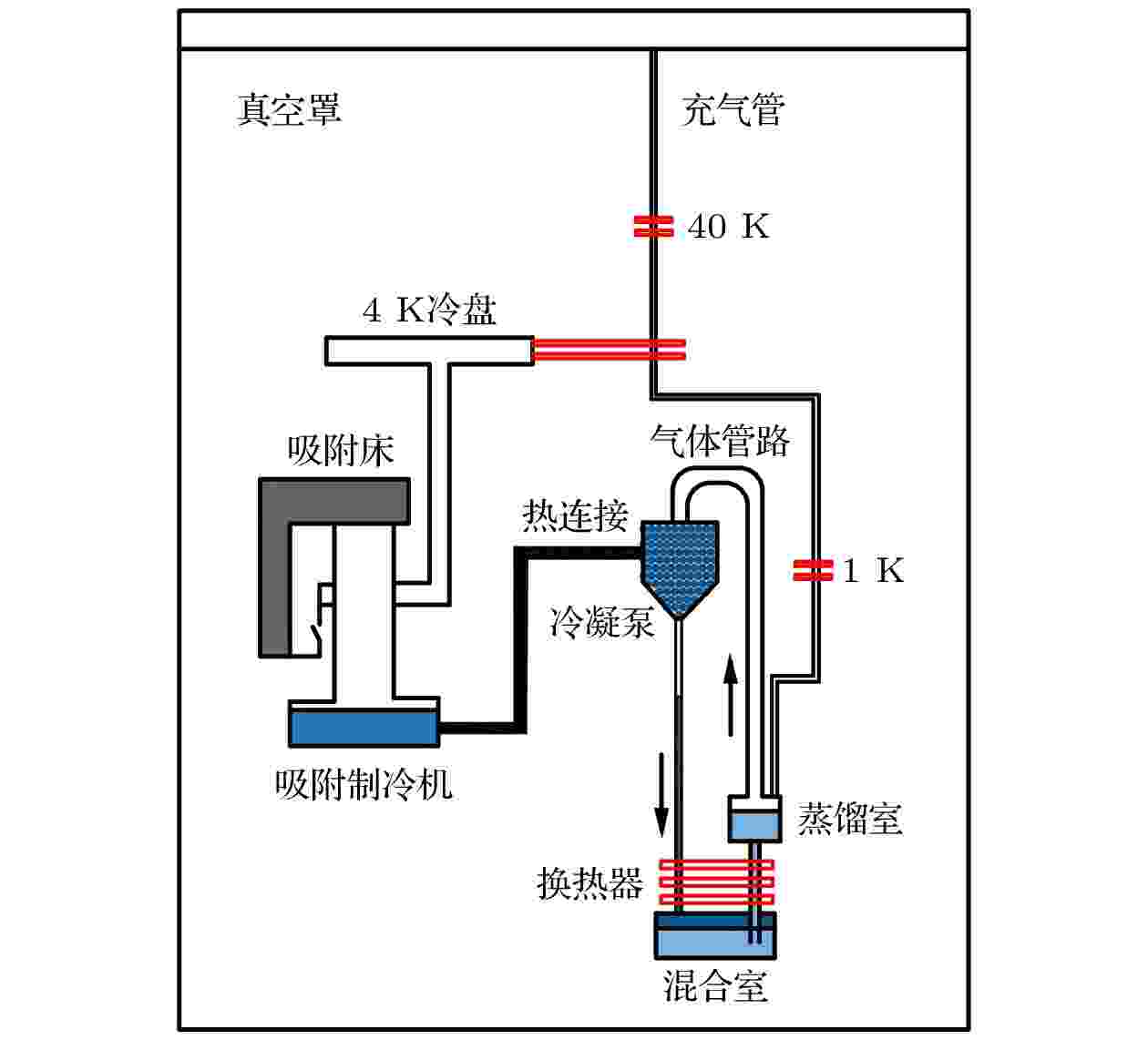
EDITOR'S SUGGESTION
2023, 72 (8): 080701.
doi: 10.7498/aps.72.20222257
Abstract +
ATOMIC AND MOLECULAR PHYSICS

2023, 72 (8): 083101.
doi: 10.7498/aps.72.20222410
Abstract +
High-order harmonic generation (HHG) from the molecular ions stretched to large internuclear distances is studied numerically and analytically in this work. We focus on the fine structure of the HHG spectrum related to the contribution of short electron trajectory. In our numerically solving the time-dependent Schrodinger equation (TDSE), we use a trajectory-dependent filtering procedure to separate the short-trajectory contribution from other contributions of long trajectory and multiple returns. Our TDSE results reveal that the short-trajectory HHG spectra of molecular ion with larger internuclear distance show some complex interference structures characterized by some remarkable dips, and that the position of the dip is sensitive to the laser parameters. With a developed model arising from strong-field approximation (SFA), we are able to identify the physical origins of the complex interference structures. In this model considered is the charge-resonance effect which induces the strong coupling between the ground state and the first excited state of the molecular ion at large internuclear distance. In this model, the well-known effect of two-center interference occurs in the form of the canonical momentum instead of the momentum related to the instantaneous velocity of the electron in the general SFA. It is shown that some dips in TDSE results arise from two-center interference of the electronic wave between these two atomic cores of the molecule in the ionization process, while others come from that in the recombination process. These ionization and recombination dips alternately appear in the HHG spectra from the formed complex interference structures. The main differences between the interference effects in the ionization process and the recombination process are twofold. Firstly, in the ionization process, the destructive two-center interference strongly suppresses the forming of the continuum wavepacket, while in the recombination process, the recombination of the rescattering electron with other bound eigenstates with small weights can also contribute to HHG bedsides the recombination of the ground state with the first excited state with large weights. As a result, in TDSE results, the ionization dips are deeper and more remarkable than the recombination ones. Secondly, in the recombination process, the Coulomb acceleration remarkably changes the de Broglie wavelength of the rescattering electron and therefore changes the position of the interference-induced dip. While in the ionization process, the Coulomb potential plays a small role in the interference effect. As a result, the interference dips in the ionization process and the recombination process differ from each other.

2023, 72 (8): 083201.
doi: 10.7498/aps.72.20222314
Abstract +
The rotation, translation, and vibration of many amino acid molecules fall in the terahertz (THz) range, thus qualitative and quantitative researches of amino acids can be carried out through their THz absorption characteristic fingerprint peaks. In this work, the room-temperature THz absorption spectra of DL-glutamic acid and its monohydrate at 0.5–3.0 THz are measured by utilizing terahertz time-domain spectroscopy (THz-TDS). It is found that the THz characteristic peaks of these two amino acids are obviously different from each other. Moreover, according to the changes of the absorption amplitude of the characteristic absorption peak (1.24 THz) of DL-glutamate monohydrate at different sample concentrations, the mixed samples of DL-glutamate and its monohydrate are quantitatively analyzed, and the quantitative analysis formula is verified. In addition, the optical mode of DL-glutamic acid and its monohydrate in THz region are predicted by using density functional theory (DFT). On condition that the theoretical data are matched with the experimental peaks, the origins of THz absorption peaks obtained in the experiment are discussed and summarized. The results show that the THz characteristic peaks (<2.80 THz) of DL-glutamic acid and its monohydrate come from the intermolecular interactions, and the other absorption peaks result from the combination of intermolecular and intramolecular interactions.
ELECTROMAGNETISM, OPTICS, ACOUSTICS, HEAT TRANSFER, CLASSICAL MECHANICS, AND FLUID DYNAMICS

EDITOR'S SUGGESTION
2023, 72 (8): 084201.
doi: 10.7498/aps.72.20222463
Abstract +
Ray tracing plays a key role in lens design area, and it is an important tool to study the problems in physics like optics. Nowadays, ray tracing becomes ubiquitous and is widely used in optical automatic design, such as aberration analysis, optimization, and tolerance calculation. With the impulse of application requirements, optical systems like space camera develop towards large scale, high degree of accuracy and complication. The magnitude of aberrations increases exponentially with the growth of focal length and aperture, even a minor perturbation error can result in severe degeneration of image quality. As a consequence, the stringent requirements for precision, accuracy and stability of ray tracing turn higher. Reliable commercial software, for example, America’s Zemax, has high precision in ray tracing, because of commercial purpose, the process of ray tracing is a black box. It is now more important to understand what error factors are formed for ray tracing, and how these running errors can be reduced effectively. In this paper, from floating point arithmetic perspective, an error model for ray tracing is provided. This error model is suitable for not only meridional rays, but also skew rays. Starting from IEEE Standard for Binary Floating-Point Arithmetic, presentation error and rounding error are analyzed, followed by the computation process of ray’s intersection point with a quadratic surface, then rounding error expression for the intersection point is presented. In addition, error expression for distance along the ray from the reference surface to the next surface is also induced. These two error expressions are called error model, and it clearly indicates that spatial coordinates on the reference surface, direction vector and distance between the two adjacent surfaces are the main error sources. Based on the error model, some of effective measures, for instance, reprojection, spatial transformation, and direction vector’s normalization are taken to reduce the rounding error. Moreover, in the process of solving quadratic equation, conjugate number method is utilized in order to avoid increasing substantially in relative error called catastrophic cancellation. Numerical experiments and classical optical design for space camera are also given. From numerical computing view, two precision tests based on Multiple Precision Floating-Point Reliable (MPFR) library are introduced to verify our method mathematically. The experimental results show that our algorithm has the same precision (14 significant digits) as MPFR, while the existing method fails to pass tests, and has only 8 significant digits at most. Moreover, both the Cassegrain space camera and off-axis three-mirror-anastigmat space camera are used to illustrate our method’s accuracy. Experimental results indicate that our method has higher precision, more than 5 to 6 orders of magnitudes than the existing method. In addition, our algorithm has higher precision than the commercial optical design software Zemax, and residuals are 3 orders of magnitudes on average less than Zemax.

2023, 72 (8): 084202.
doi: 10.7498/aps.72.20222336
Abstract +
Terahertz (THz) wave usually refers to the electromagnetic wave with a frequency between 0.1—10.0 THz. It has potential applications in wireless communication, biomedical image processing, nondestructive testing, military radar, and other fields. However, owing to function limitation of the natural material, multifunctional terahertz devices are difficult to design and fabricate, which becomes a bottleneck for THz technology. The emergence of metamaterials fills the gap in the electromagnetic materials in the THz frequency band, and now they are widely used in THz functional devices, such as THz modulators, THz absorbers, THz filters, THz sensors, and THz slow-light devices. However, the above-mentioned THz devices all have a single function. For practical application, multifunction integrated THz devices have broader application prospects. As is well known, the Ge2Sb2Te5 (GST) is a typical phase transition material. Under excitation of light or electronic field, GST can realize a reversible phase transition between insulating state and metallic state. In order to achieve a switchable multifunctional THz device, in this work we design a THz metamaterial based on the phase transition material GST and realize a switchable function with slow-light and absorption functions. The THz metamaterial consists of a microstructure layer, which is composed of gold rings arranged periodically, and a GST thin film spaced by an SiO2 dielectric layer. When GST is in an insulating state, the two gold rings are coupled to each other under the excitation of the THz pulse. Then, we can observe the EIT-like effect. The THz pulses propagating in the metamaterial we proposed can be slowed down, and a maximum group delay of the THz pulse can reach 3.6 ps. However, when GST is in a metallic state, we can observe two absorption peaks in the spectrum of the proposed THz metamaterial, and the absorption rate is 97% at a frequency of 0.365 THz and 100% at a frequency of 0.609 THz. Furthermore, we also investigate the polarization properties of the proposed THz metamaterial, and find that it has polarization insensitive characteristic. When the polarization angle of the incident THz light pulse changes from 0° to 90°, the slow-light and absorption properties of the THz metamaterial are unaffected. The proposed THz metamaterial has potential applications in THz biomedical image processing, THz optical switching, and THz optical buffer.
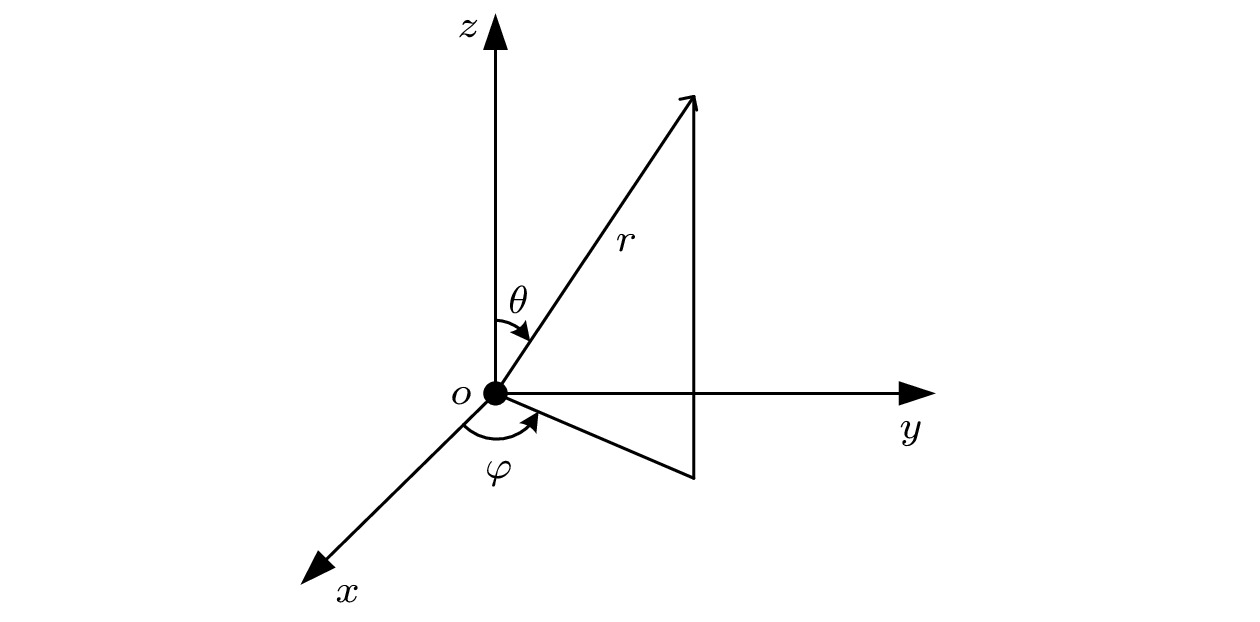
2023, 72 (8): 084203.
doi: 10.7498/aps.72.20222406
Abstract +
Metal droplet is produced accompanied with vacuum arc discharge, which is important to the research of cathode spot and the application of vacuum arc. The droplet comes from the cathode spot crater and can reflect the physical process of the cathode spot. However, it will destroy the uniformity of surface deposition in engineering and should be avoided as much as possible. The measurement of metal droplet usually adopts off-line collector, which cannot obtain the signal of the whole space and singe arc. In order to on-line measure the droplet, a new method by the Mie scattering is developed in this work, and its feasibility is investigated. The characteristic of the scattering light of titanium droplet is computed by the simulation code. The results indicate that the scattering light beams of the small droplet are distributed at all angles. With the increase of the diameter, the scattered light beams are more and more concentrated in the forward direction, which allows the inversion of the signals of the droplets with different diameters. Then the detector is designed with different annuluses. When the detector is divided into 35 annuluses, the light energy coefficient matrix is easy to solve and the measurement system has a good resolution. The experimental setup is built and the preliminary experiment is carried out. The results indicate that the diameters of titanium droplets are mainly around 9.8 μm, which verifies the effectiveness of the Mie scattering method of measuring vacuum arc droplets. However, the small droplet information is not detected, so the droplet diameter distribution is quite different from the off-line measurement. The reason is that the signal-to-noise ratio of the measurement system is poor, thereby leading the scattered signals of the small droplet to fail to be obtained effectively. The experimental setup need to be further optimized.

2023, 72 (8): 084204.
doi: 10.7498/aps.72.20221965
Abstract +
Based on the current growth technology of quantum dot in the experiment, considering that the probe fields and control fields at different frequencies are coupled between different energy levels of the InAs/GaAs quantum dot, the ladder-type, Λ-type and V-type energy level configurations can be formed. The linear and nonlinear properties of these energy level configurations of InAs/GaAs quantum dots are studied by using semiclassical theory combined with multiple scale method. It is shown that in the linear case, electromagnetic induction transparency windows can be formed among ladder-type, Λ-type and V-type energy level configurations. And the width of the transparent window increases with the strength of the control pulse increasing. For the nonlinear case, under the current experimental condition, optical solitons can be formed and stored in ladder-type configuration and $ {{\Lambda }} $ -type energy level configuration. However, optical solitons cannot be formed in the V-type energy level configurations, which is because the nonlinear effect of the system is very weak. Furthermore, it is demonstrated that the fidelity of the storage and retrieval of the optical solitons is higher than that of linear optical pulse and strongly nonlinear optical pulse. Interestingly, it is also found that the amplitude of stored optical solitons in $ {{\Lambda }} $ -type energy level configuration is higher than that in ladder-type energy level configuration. This study provides a theoretical basis for semiconductor quantum dot devices to modulate the amplitude of the stored optical solitons.

EDITOR'S SUGGESTION
2023, 72 (8): 084206.
doi: 10.7498/aps.72.20222343
Abstract +
Quantum optical frequency combs are of great significance in the fields of quantum computing, quantum information, and high precision quantum measurement, which can be produced by using a degenerate type-I synchronously pumped optical parametric oscillator (SPOPO). When anisotropic crystal is used as a nonlinear medium in the SPOPO, the spatial walk-off effect will occur due to the birefringence effect, which cannot be ignored and will adversely affect the generation of squeezed state. In this work, we investigate the influence of spatial walk-off effect on the squeezing level of quantum optical frequency combs both theoretically and experimentally. A Ti∶sapphire mode-locked femtosecond pulsed laser which produces 130 fs pulse trains at 815 nm with a repetition rate of 76 MHz is utilized as a fundamental source. Its second harmonic at 407.5 nm is used to pump the collinear BiB3O6 (BIBO) crystal for generating the squeezed vacuum frequency comb. It is indicated that as the crystal length increases, the area of interaction between pump light and signal light decreases gradually. Thus the enhancement of squeezing is eventually limited by the spatial walk-off effect. According to the simulations, the squeezing level reaches a maximum value when the crystal length is 1.49 mm. The quantum properties of squeezed vacuum optical frequency combs obtained for four crystal lengths (0.5, 1.0, 1.5 and 2.0 mm) are subsequently measured experimentally. When the length of BIBO is 1.5 mm, the maximum vacuum squeezing of (3.6±0.2) dB is obtained, which is (7.0±0.2) dB after being corrected for detection loss. The experimental results are consistent with the numerical simulations. This study demonstrates that the spatial walk-off effect in nonlinear crystal is a significant factor affecting the quantum optical frequency comb, and the theoretical model presented in this paper can be used to provide a guideline for optimizing the experimental implementation.
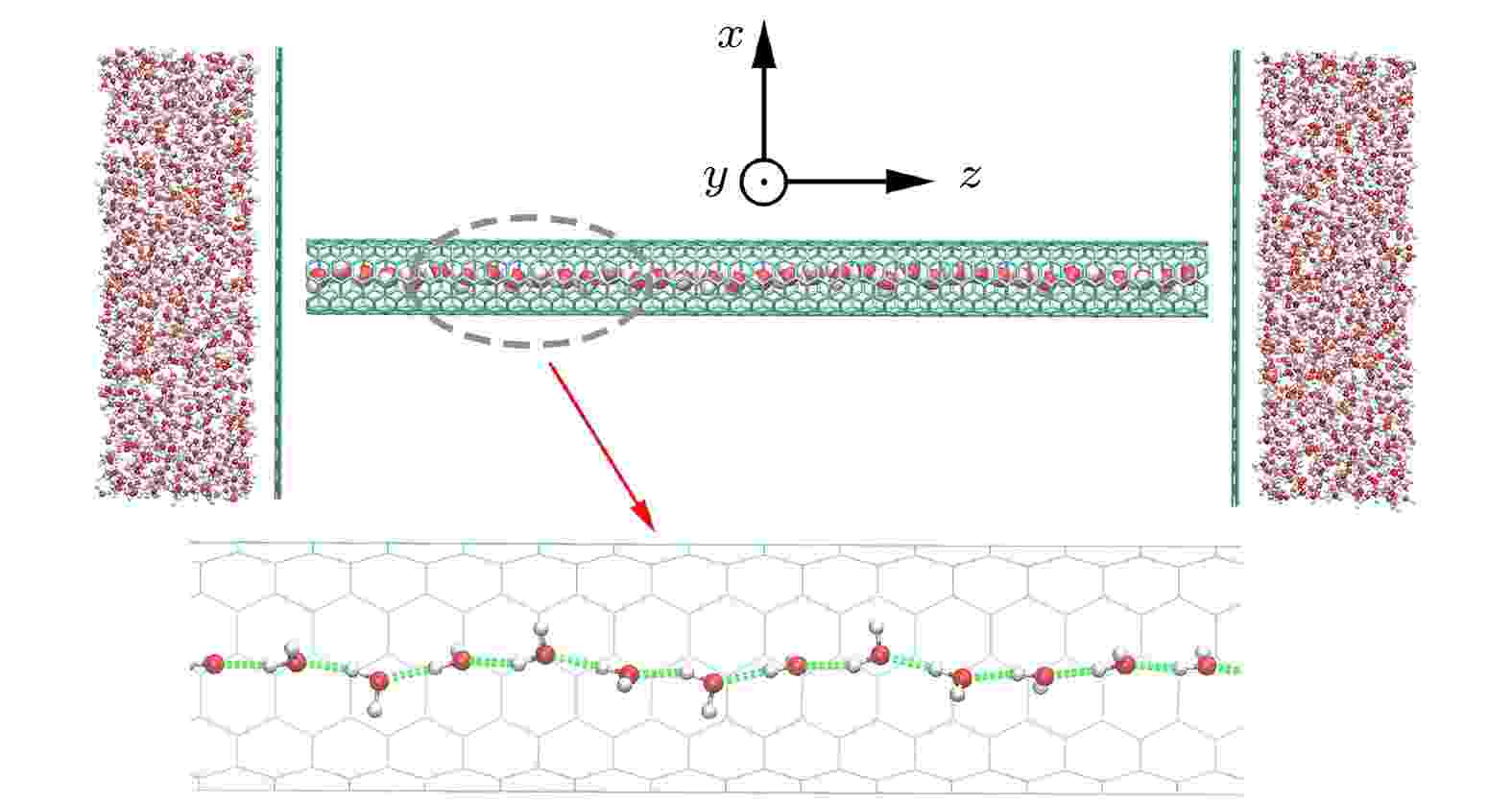
2023, 72 (8): 084207.
doi: 10.7498/aps.72.20222031
Abstract +
Compared with bulk water (BW), the water in nanochannels usually shows unique structural and dynamic properties, which is still unable to be effectively detected and characterized by existing experimental techniques. The spectrum is an effective technical means for studying and identifying the material composition and characteristics. In this study, the infrared absorption spectra of one-dimensional ordered single-file water (SW) confined in (6, 6) single-walled carbon nanotubes are calculated by molecular dynamics simulation. It is found that the ordered arrangement of SW results in an obvious blue shift and enhancement of the spectral peak in the 0–35 THz range relative to the bulk water. The analysis shows that this phenomenon is caused by the change of coupling weight of libration vibrations (including rock, twist and wag modes) of SW. The twist vibration mode and wag vibration mode with higher frequency are relatively easy to occur because the binding energy decreases under the single chain structure of water, which results in the blue shift and enhancement of the spectral peak. Meanwhile, the present study shows that the spectral component characteristics of SW can well predict and explain the structural and dynamic properties of SW. Further, terahertz simulation experiments show that the infrared absorption capacity of SW basically conforms with the spectral distribution characteristics.
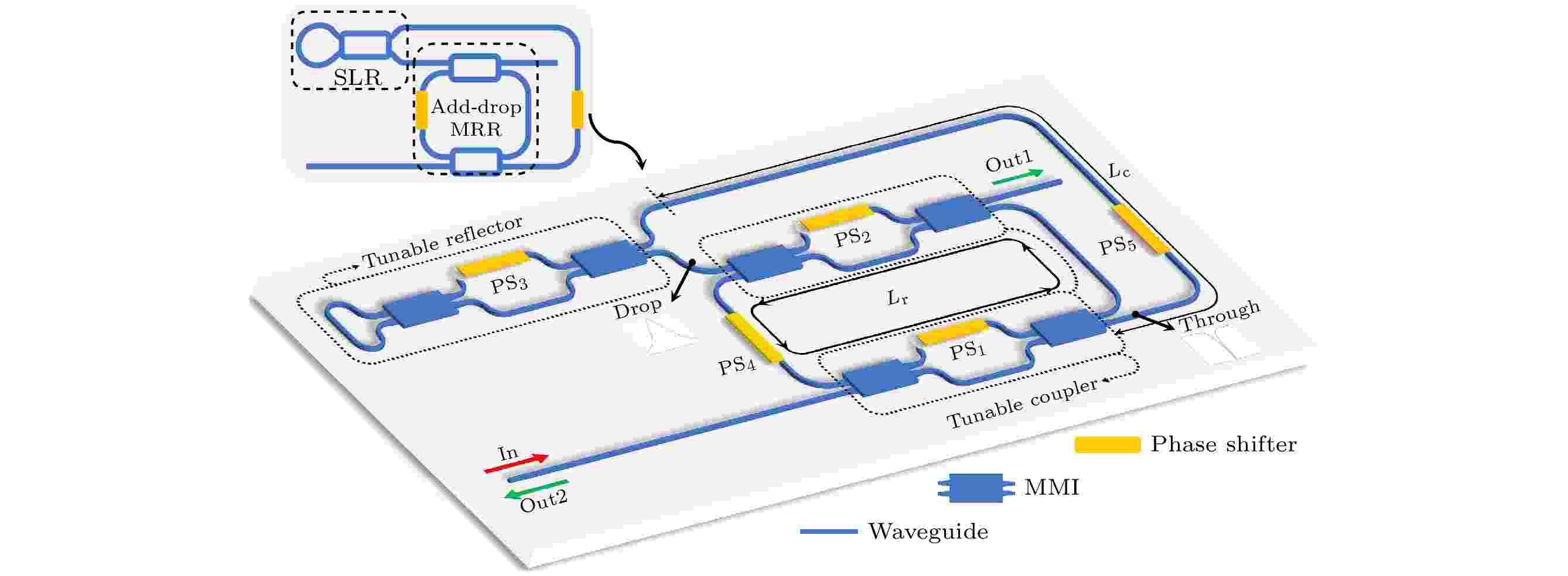
2023, 72 (8): 084208.
doi: 10.7498/aps.72.20222384
Abstract +
To meet the demands for various applications in optical filtering and microwave signal processing, integrated silicon photonic filters are required to be multifunctional, reconfigurable and tunable. In this work, an integrated multi-functional optical filter is proposed, which is designed based on a tunable Sagnac loop reflector and a microring resonator. The through port and drop port of an add-drop microring resonator are connected with the two ports of a tunable reflector. By controlling the thermal phase shifters in different scenarios, the device can be reconfigured into a reflective-type asymmetric Mach-Zehnder interferometer filter, a reflective-type all-pass microring resonator filter and self-interference microring resonator filters. An analytical model is established based on the transfer matrix. The simulation results show that the device can achieve the following functions: sinusoidal spectral filtering with four different free spectral ranges, Lorentzian spectral filtering toggling between band pass and band stop, and spectral reconfigurations of Fano resonance, electromagnetically induced transparency, and electromagnetically induced absorption. Each spectrum mentioned above can be tuned fast and widely. Reflection provides a new degree of freedom in design, breaks through the inherent footprint limit, and achieves a wide range of free spectral ranges. Our proposed tunable Sagnac loop reflector assisted microring resonator provides a new scheme for realizing flexible, tunable and multi-functional reconfigurable integrated photonic filters, and has broad applications in the integrated photonic analog signal processing and microwave photonics.
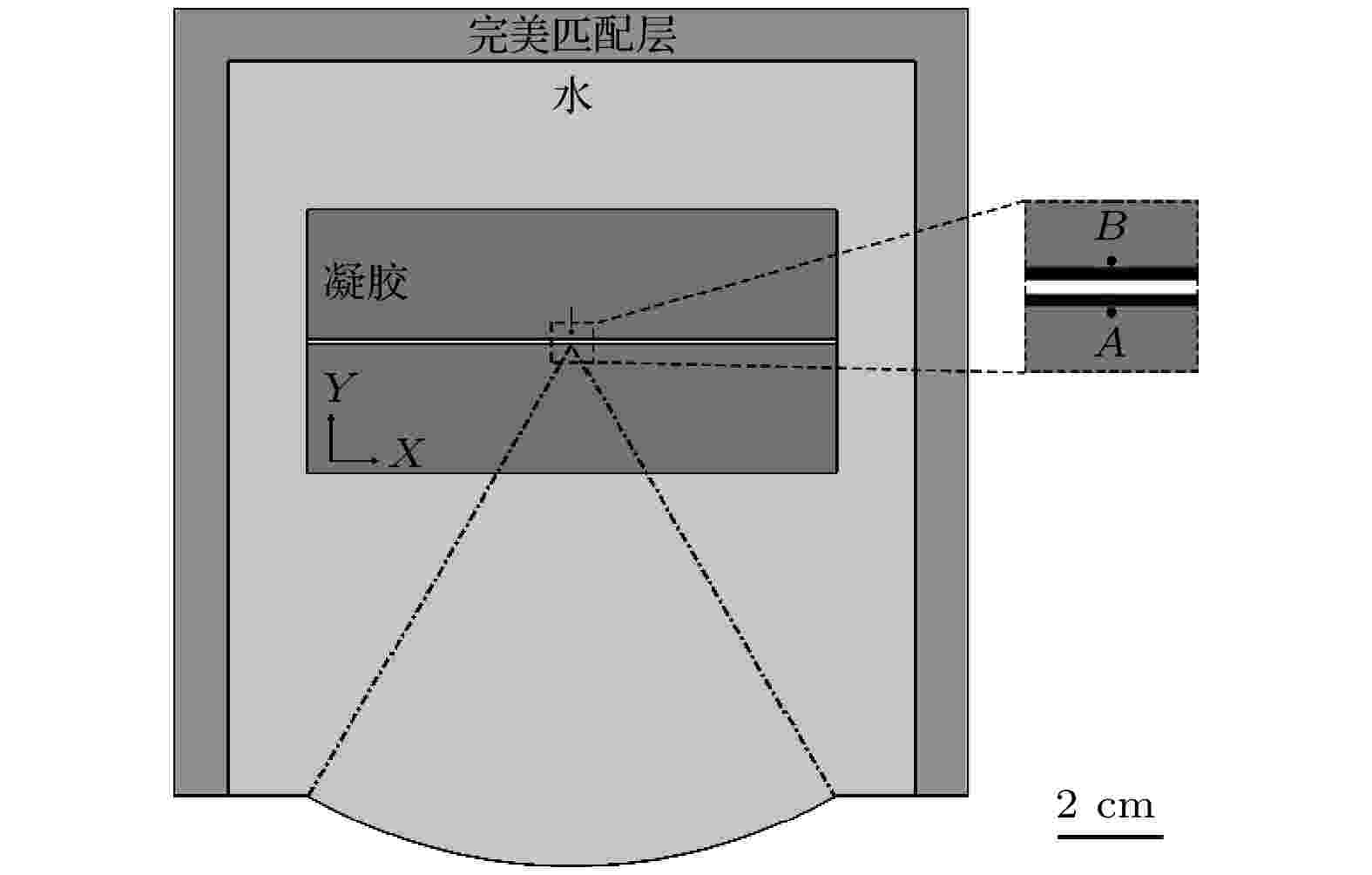
EDITOR'S SUGGESTION
2023, 72 (8): 084301.
doi: 10.7498/aps.72.20230068
Abstract +
Development of acoustic/magnetic contrast agent microbubbles with various diagnostic and therapeutic functions has attracted more and more attention in medical ultrasound, biomedical engineering and clinical applications. Superparamagnetic iron oxide nanoparticles (SPIO) have unique magnetic characteristics and wonderful biocompatibility, so they can be used as MRI contrast agents to improve image contrast, spatial resolution and diagnostic accuracy. Our previous work shows that the multimodal diagnostic and therapeutic microbubble agents can be successfully constructed by embedding SPIO particles into the coating shell of conventional ultrasound contrast agent (UCA) microbubbles, which in turn changes the size distribution and shell properties of UCA microbubbles, thereby affecting their acoustic scattering, cavitation and thermal effects. However, previous studies only considered the influence factors such as acoustic pressure and microbubble concentration. The relevant investigation regarding the influence of ultrasound temporal characteristics on the dynamic response of magnetic microbubbles is still lacking. This work systematically measures the temperature enhancement effect of the SPIO-albumin microbubble solution flowing in the vascular gel phantom exposed to pulsed ultrasound with various temporal settings (e.g. duty cycle, PRF and single pulse length). Meanwhile, a two-dimensional finite element model is developed to simulate and verify the experimental observations. The results show that the increase of duty cycle of pulse signal should be the crucial factor affecting the temperature enhancement effect of flowing SPIO-albumin microbubble solution under the exposure to high-intensity focused ultrasound. The current results help us to better understand the influence of different acoustic setting parameters on the thermal effect of dual-modal magnetic UCA microbubbles, and provide useful guidance for ensuring the safety and effectiveness of the application of SPIO-albumin microbubbles in clinics.

2023, 72 (8): 084302.
doi: 10.7498/aps.72.20222361
Abstract +
Estimating the depth of a moving source with unknown source range is always a challenging problem in shallow water waveguides. The method of estimating the current motion source depth is sensitive to the unknown initial range and requires the horizontal synthetic aperture length formed by the motion of the source to be much longer than the modal interference period. Presented in this work is a method to estimate the depth of moving source based on the incoherently matched beam-wavenumber. In the beam-wavenumber domain, each peak amplitude only contains the modal excitation related to source depth, and each peak position corresponds to the mode propagation angle and the horizontal wavenumber. In this method, the received data are first used to perform beam-formed transformation in the vertical depth and horizontal synthetic aperture direction, and transformed into the beam-wavenumber domain. Then beam-wavenumber peak amplitudes are extracted and incoherently matched with the modal depth function to estimate the source depth. The proposed method is used to eliminate the unknown distance dependent term and improves the mode resolution by performing mode separation in the beam-wavenumber two-dimensional domain. The prominent feature of this method lies in realizing the source depth estimation at the unknown initial range and the horizontal synthetic aperture length which is smaller than the mode interference period. The simulation and SWellEx-96 experimental data processing results validate the superior performance of the proposed method.
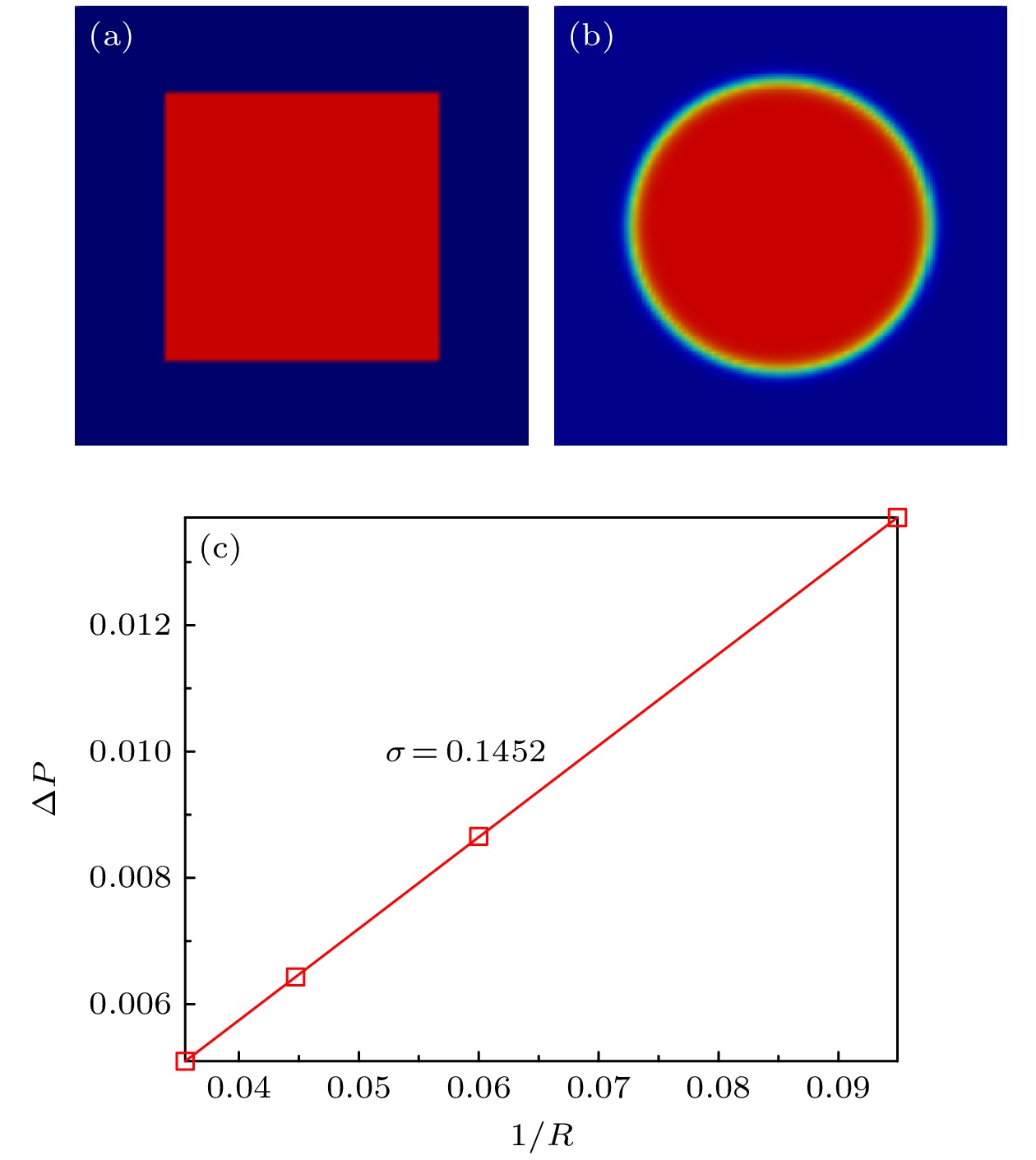
2023, 72 (8): 084701.
doi: 10.7498/aps.72.20222421
Abstract +
Immiscible two-phase flow exists in many fields such as the chemical engineering, energy engineering, and geography. It is of great significance in enhancing the oil recovery and geological carbon dioxide storage. Relative permeability is a comprehensive reflection of the effects of various factors including the saturation, contact angle, viscosity ratio, and capillary number of immiscible two-phase flow, and it is a key parameter describing such a flow and thus can directly reflect the flow capacity of each phase. As a new fluid numerical calculation method, the lattice Boltzmann method (LBM) has its own unique advantage in simulating various flows because it does not need to capture the phase interface, and thus has been widely used in recent years. In this research, the multi-relaxation time multi-component pseudopotential lattice Boltzmann method is improved to make it possible to solve the two-phase relative permeability under high viscosity ratios. It is known that the LBM is a particle-based hydrodynamic method, with the spontaneous diffusion of components in multi-component system inevitably causing a mixing between components, leading to distortion of the velocity of two-phase flow with a high viscosity ratio. The color gradient model is introduced into the pseudopotential model for the treatment of mixing, the multiple relaxation time is employed to improve the numerical stability and viscosity ratio range, and the numerical distortion caused by mixing is therefore resolved. The resulting model is validated by the use of the two-phase layered flow in a 2D infinite channel, and accurate numerical results are obtained even if the viscosity ratio reaches 1000. Based on the improved model, the two-phase flow in a two-dimensional horizontal channel is analyzed and the effects of saturation, viscosity ratio, wettability and capillary number on relative permeability and phase permeation curves are investigated. The results show that the relative permeability of the high-viscosity phase increases with the increase of the viscosity ratio, and the saturation range for maintaining high flow capacity broadens with the increase of the low-viscosity phase. There is a limit for the influence of viscous coupling effect on the relative permeability of two phases: at a certain saturation, the relative permeability of the small viscosity phase has a minimum value while that of the large viscosity phase has a maximum value, the viscous coupling effect will never make the relative permeability of the small viscosity phase to be lower than the minimum value and that of the large viscosity phase to be higher than the maximum value. Non-wetting condition plays a role in increasing the flow capacity and relative permeability of the high-viscosity phase, while the wetting condition can weaken the flow capability, relative permeability of the high-viscosity phase. When the high-viscosity phase is a non-wetting phase, the decrease of the contact area with the solid wall increases its proportion in the middle flow passage, which enables it to maintain a strong flow capability in a wide saturation range. Wall wetting tends to inhibit fluid flow and consequently reduce the relative permeability. The increase of the capillary number may cause a more obvious contact angle hysteresis effect, which reduces the relative permeability of two phases.
PHYSICS OF GASES, PLASMAS, AND ELECTRIC DISCHARGES
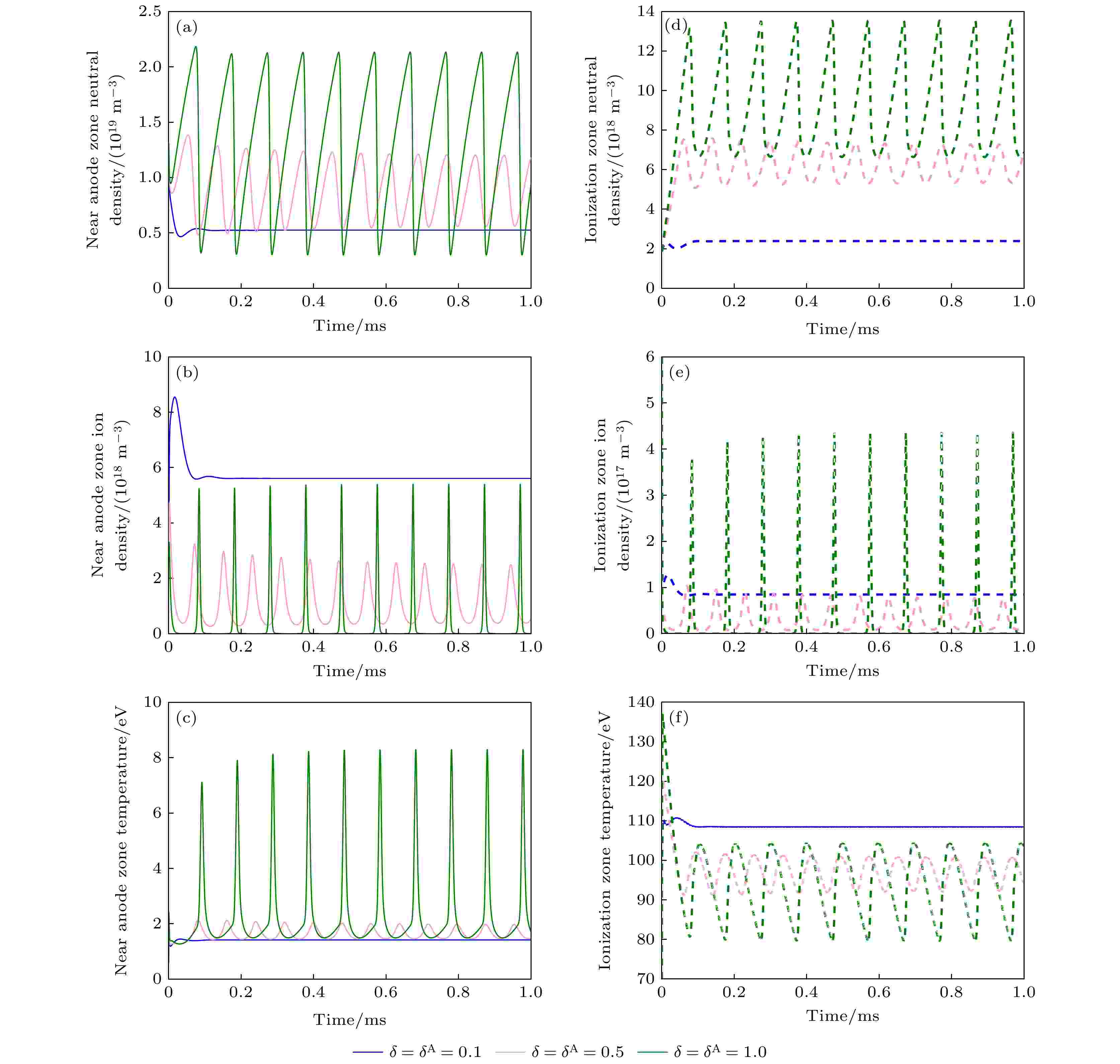
2023, 72 (8): 085201.
doi: 10.7498/aps.72.20230009
Abstract +
Breathing oscillations as one of the low frequency, large amplitude discharge instabilities have serious influence on the performance and lifetime of Hall thrusters. In order to acquire a better understanding of the breathing-oscillation in the Hall thrusters and provide the effective suppression methods for breathing-oscillation, the excitation mechanism and influence factors of the breathing oscillations are investigated by utilizing the two-zone predator-prey (P-P) model in this paper. The two-zone P-P model divides the discharge channel of Hall thruster into two parts according to the working principle of Hall thruster: one is the near anode zone and the other e is the ionization zone. The model includes the ion radial diffusion effect and electrons-wall interaction effect. The four-order Range-Kuttle method is utilized to solve the nonlinear two-zone P-P model equation. The research results show that the interaction of electrons with the wall has the inhibition effect on the breathing oscillations caused by the energy consumption due to the colliding with discharge channel wall. However, ion radial diffusion effect which is near anode has an excitation effect on the breathing oscillation. The ion and neutral atom dynamic behaviors obviously show the P-P feature in the phase space. In other words, there is a phase difference between the change of ion density and the change of neutral particle density. Relying on the intensity of the ions radial diffusion effect, the mode oscillation frequency and oscillation amplitude of discharge current present non monotonic change trend. More specifically, with the increase of intensity of ion radial diffusion effect, the oscillation frequency first increases and then decreases. However, the discharge peak current first decreases and then increases. Furthermore, the breathing oscillations excitation is irrelevant to the length of ionization zone, and the oscillation frequency increases (oscillation period) with length of ionization zone increasing (decreasing), provided that the length of discharge channel is constant. The research results of this paper will provide support to make clear the excitation mechanism and propose the new method of suppressing the breathing oscillations in the hall thrusters.

2023, 72 (8): 085202.
doi: 10.7498/aps.72.20222394
Abstract +
Plasma simulation is important in studying the plasma discharge systematically, especially the anode layer ion source which has the complex geometrical characteristics of the discharge structure. However, owing to the complex solution domain formed by the geometric profile of the anode and cathode, the traditional simulation models show extremely small computational efficiency and poor convergence. This work presents a separate simulation for the ion source structure and the plasma discharge, separately, where the cathode geometric parameters (including the size, the shape and the relative position of the inner and outer cathodes) are simplified into two magnetic mirror parameters (the magnetic mirror ratio Rm and the magnetic induction intensity in the center of the magnetic mirror B 0), and then a high-efficient particle-in-cell/Monte Carlo collision (PIC/MCC) model is established to improve the computational efficiency and stability of the plasma simulation later. As a result, the convergence time of the plasma simulation is shortened significantly from 1.00 μs to 0.45 μs, and by which the influences of the geometrical characteristics of the discharge structure on the plasma properties are systematically studied. The simulation results reveal that magnetic mirror with Rm = 2.50 and B 0 = 36 mT can best confine the plasma in the central area between the inner cathode and outer cathode. When the discharge center of the plasmacoincides with the magnetic mirror center, the anode layer ion source presents both high density output of ion beam current and significantly reduced cathode etching, suggesting that the best balance is obtained between the output and cathode etching.
CONDENSED MATTER: STRUCTURAL, MECHANICAL, AND THERMAL PROPERTIES
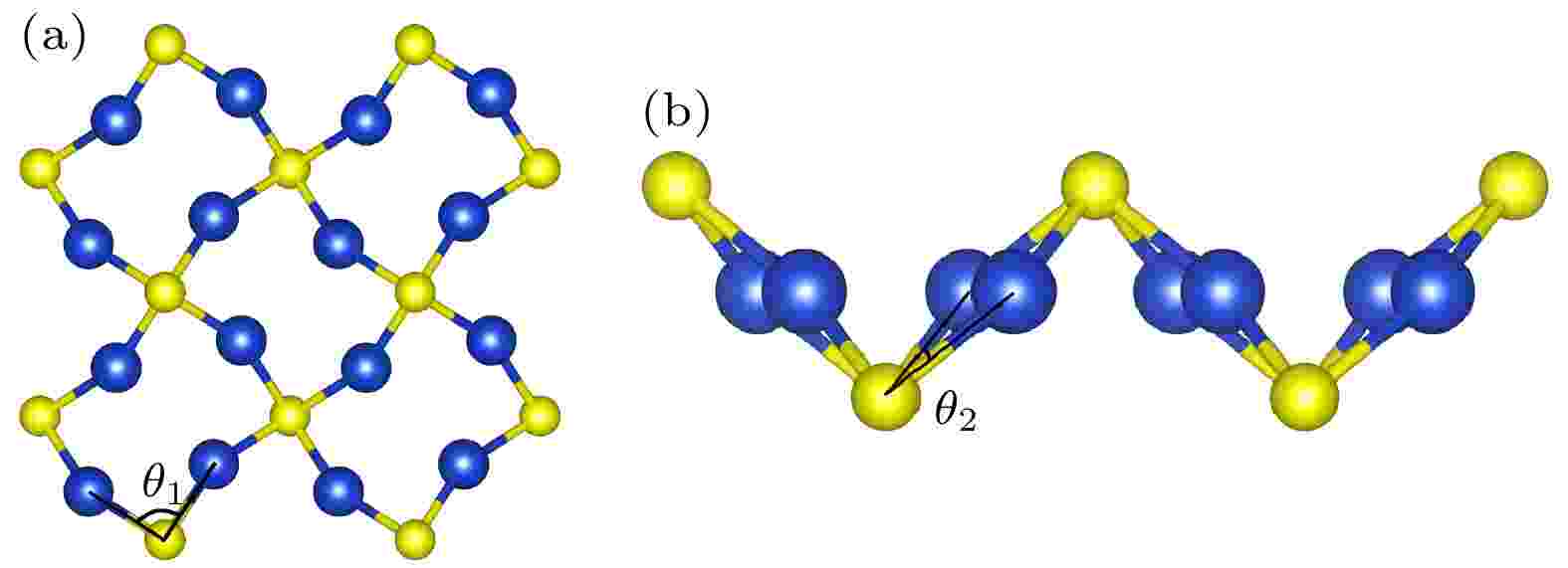
2023, 72 (8): 086301.
doi: 10.7498/aps.72.20222015
Abstract +
Two-dimensional (2D) materials with lower lattice thermal conductivities and high figures of merit are useful for applications in thermoelectric (TE) devices. In this work, the thermoelectric properties of monolayer Cu2S and Cu2Se are systematically studied through first-principles and Boltzmann transport theory. The dynamic stability of monolayer Cu2S and Cu2Se through elastic constants and phonon dispersions are verified. The results show that monolayer Cu2S and Cu2Se have small lattice constants, resulting in lower phonon vibration modes. Phonon transport calculations confirm that monolayer Cu2Se has lower lattice thermal conductivity (1.93 W/(m·K)) than Cu2S (3.25 W/(m·K)) at room temperature, which is due to its small Debye temperature and stronger anharmonicity. Moreover, the heavier atomic mass of Se atom effectively reduces the phonon frequency, resulting in an ultra narrow phonon band gap (0.08 THz) and a lower lattice thermal conductivity for monolayer Cu2Se. The band degeneracy effect at the valence band maximum (VBM) of monolayer Cu2S and Cu2Se significantly increase their carrier effective mass, resulting in higher Seebeck coefficients and lower conductivities under p-type doping. The electric transport calculation at room temperature shows that the conductivity of monolayer Cu2S (Cu2Se) under n-type doping about 1011 cm–2 is 2.8×104 S/m (4.5×104 S/m), obviously superior to its conductivity about 2.6×102 S/m (1.6×103 S/m) under p-type doping. At the optimum doping concentration for monolayer Cu2S (Cu2Se), the n-type power factor is 16.5 mW/(m·K2) (25.9 mW/(m·K2)), which is far higher than p-type doping 1.1 mW/m·K2 (6.6 mW/(m·K2)). Through the above results, the excellent figure of merit of monolayer Cu2S (Cu2Se) under optimal n-type doping at 700 K can approach to 1.85 (2.82), which is higher than 0.38 (1.7) under optimal p-type doping. The excellent thermoelectric properties of monolayer Cu2S (Cu2Se) are comparable to those of many promising thermoelectric materials reported recently. Especially, the figure of merit of monolayer Cu2Se is larger than that of the well-known high-efficient thermoelectric monolayer SnSe (2.32). Therefore, monolayer Cu2S and Cu2Se are potential thermoelectric materials with excellent performances and good application prospects. These results provide the theoretical basis for the follow-up experiments to explore the practical applications of 2D thermoelectric semiconductor materials and provide an in-depth insight into the effect of phonon thermal transport on improvement of TE transport properties.

2023, 72 (8): 086401.
doi: 10.7498/aps.72.20222334
Abstract +
CONDENSED MATTER: ELECTRONIC STRUCTURE, ELECTRICAL, MAGNETIC, AND OPTICAL PROPERTIES
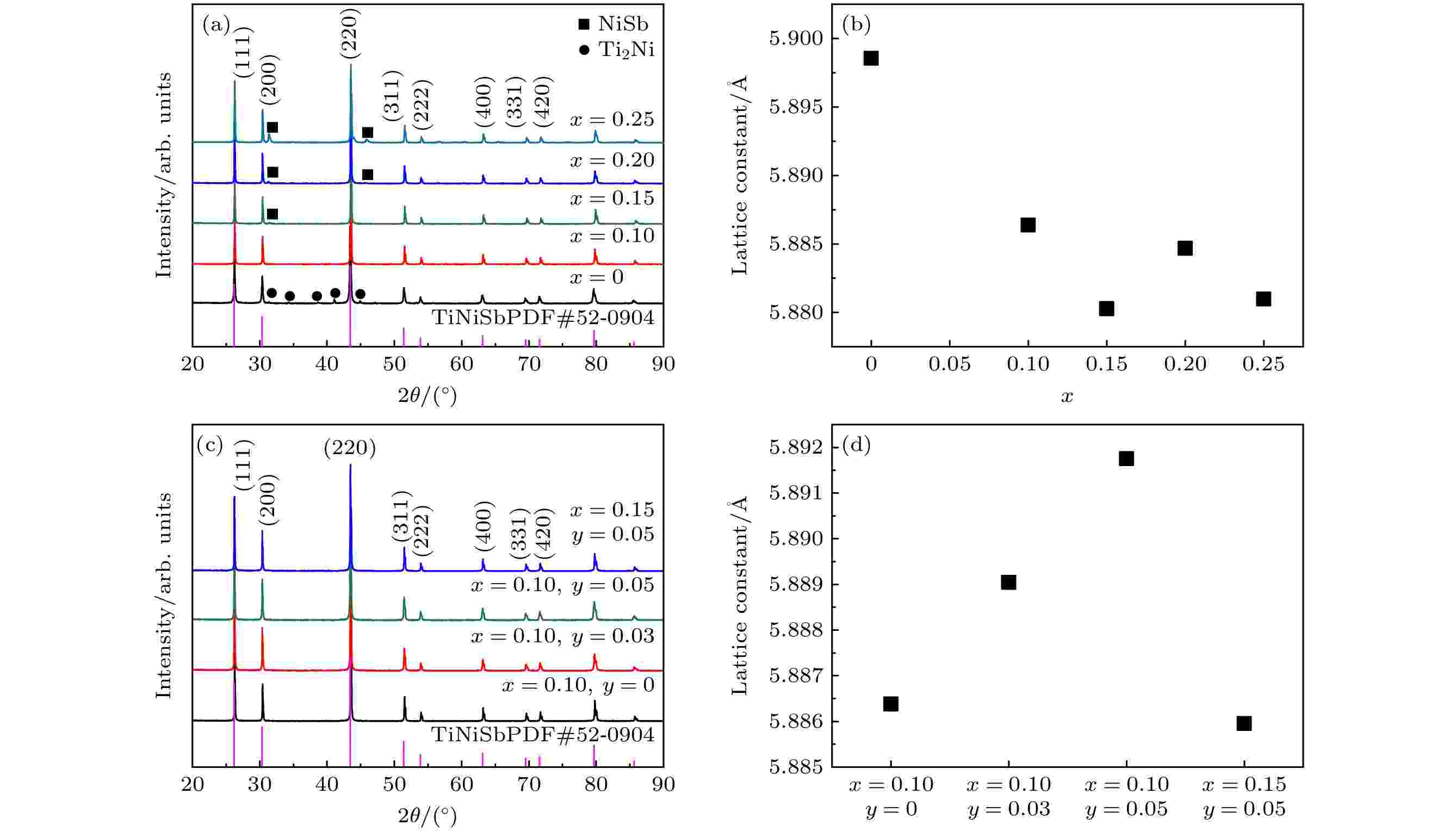
2023, 72 (8): 087201.
doi: 10.7498/aps.72.20230035
Abstract +
The nominal composition TiNiSb with 19 valence electrons is demonstrated to be composed of off-stoichiometric half-Heusler phase and impurities. In this work, the Ti1–xNiSb (x = 0, 0.10, 0.15, 0.20, 0.25) samples are prepared by ball milling and spark plasma sintering. The single-phase Ti0.9NiSb sample, deviating from the theoretical composition Ti0.75NiSb base on 18-electron rule, is obtained, which might be ascribed to the small defect formation energy of Ti filling the vacancy as well as our ball-milling preparation method. With the single-phase Ti0.9NiSb sample used as the base material, a small amount of Sc is used to partially replace Ti in order to further reduce the carrier concentration. Thus, the Ti1–x–yScyNiSb (x = 0.10, 0.15; y = 0.03, 0.05) samples are designed to investigate the effect of Sc doping on the thermoelectric properties. The X-ray powder diffraction (XRD) and scanning electron microscopy (SEM) analysis confirm the single-phase nature of the Ti1–x–yScyNiSb samples. Energy-dispersive X-ray spectroscopy (EDS) results indicate that the actual compositions of the Ti1–x–yScyNiSb samples are consistent well with their nominal compositions, and all elements are distributed uniformly in the sample. Moreover, the doping of Sc can increase the content of Ti vacancy while maintaining the single-phase structure, which could be attributed to the higher binding energy between Sc and Sb because the electronegativity of Sc is less than that of Ti. Both the substitution of Sc for Ti and the increase of the Ti vacancies significantly reduce the carrier concentration, which decreases from ~13.6 × 1021 cm–3 for Ti0.9NiSb to ~3.4 × 1021 cm–3 for Ti0.8Sc0.05NiSb. The reduced carrier concentration results in greatly increased Seebeck coefficient, therefore the Ti0.8Sc0.05NiSb sample achieves a power factor as high as 17.7 μW·cm-1·K-2 at 973 K. Although the lattice thermal conductivity of Sc-doped sample increases slightly due to the reduction of electron–phonon scattering and the enhancement of chemical bonds, the total thermal conductivity decreases dramatically due to the electronic thermal conductivity decreasing greatly. Finally, the Ti0.8Sc0.05NiSb sample reaches a ZT value of ~0.42 at 973 K, which is 180% higher than that of Ti0.9NiSb sample. Despite the fact that the thermoelectric performance of our sample is still inferior to those of the state-of-the-art off-stoichiometric 19-electron half-Heusler alloys, this work demonstrates that the thermoelectric performance of Ti1–xNiSb can be further improved by non-isoelectronic doping.

2023, 72 (8): 087202.
doi: 10.7498/aps.72.20222433
Abstract +
As the data writing scheme of magnetization reversal driven by spin-transfer torque can overcome the shortcomings of traditional magnetic-field writing mechanism, it has become a mainstream way of implementing information writing in magnetic random access memory. However, the explosive growth of information shows higher requirements for data storage and information processing, thus magnetic random access memories based on spin-transfer torque data writing method pose several issues, including barrier reliability and limited storage speed. Recent experimental studies have shown that the spin-orbit torque through the spin Hall effect or Rashba effect in heavy-metal/ferromagnetic bilayer structures has the potential advantages in overcoming these limitations. They can also be used to drive magnetization to achieve rapid reversal. Especially, the three-terminal magnetic tunnel junction separates data reading from writing current. It has the advantages of faster writing speed and better stability and thus becomes the most promising magnetic storage technique at present. The magnetization reversal driven by spin-orbit-assisted spin-transfer torque in a three-terminal magnetic tunnel junction is studied theoretically in this work. By linearizing the Landau-Lifshitz-Gilbert equation with the additional spin-transfer torque term and spin-orbit torque term in the spherical coordinates, two coupled differential equations and the new equilibrium directions are obtained. With the stability analysis of the new equilibrium directions, the phase diagrams defined in parameter space spanned by the current densities of spin-transfer and spin-orbit torques are established. There are several magnetic states in the phase diagrams, including quasi-parallel stable states, quasi-antiparallel stable states, and bistable states. By adjusting the current density of the spin-transfer torque, the magnetization reversal between two stable states is realized. It is found that the magnetization reversal time is greatly reduced with the assisting of spin-orbit torque, and it decreases with the augment of current density of spin-orbit torque. Meanwhile, the zero-field magnetization reversal can be realized through the interplay between spin-orbit torque and spin-transfer torque. In addition, compared with the damping-like term of spin-orbit torque, the field-like one plays a leading role in magnetization reversal. The presence of field-like term of spin-orbit torque can also reduce the reversal time that decreases with the increase of the ratio of field-like torque to damping-like one.

EDITOR'S SUGGESTION
2023, 72 (8): 087301.
doi: 10.7498/aps.72.20222467
Abstract +
Graphene plasmons are important collective excitations in graphene, which play a key role in determining the optical properties of graphene. They have quite lots of unique features in comparison with classical plasmons in noble metals. Of them, the active tunability is the most attractive, which is realized by external gating (equivalently electric field). As is well known, graphene also has strong magnetic response (e.g. room temperature quantum Hall effect), so magnetic field can act as another degree of freedom for actively tuning graphene plasmons, with the new quasi particles being so-called graphene magneto-plasmons. Because of the two-dimensional nature of graphene, the numerical studies (or full wave simulations) of graphene magneto-plasmons are usually carried out through a three-dimensional approximation, e.g. treating two-dimensional graphene as a very thin three-dimensional film. Actually, this treatment takes quite some time and requires high memory consumption. Herein, starting from Coulomb law and charge conservation law, we propose an alternative numerical method, namely, two-dimensional finite element method, to solve this problem. All the calculations are now performed in two-dimensional graphene plane, and the usual three-dimensional approximation is not required. To characterize the excitations of graphene magneto-plasmons, the eigenvalue loss spectrum is introduced. Based on this method, graphene magneto-plasmons in graphene rings of four kinds are investigated. The strongest magneto-optic effect is observed in circular ring, which is consistent with its highest rotational symmetry. In all the rings, the lowest dipolar graphene magneto-plasmon always supports symmetric mode splitting, which can be further modified by the interaction between inner edge and outer edge of ring. As the hole size is very small, the edge current confined to the outer edge dominates, and that confined to the inner edge can be ignored; while increasing the hole size, the interaction between these two edges increases, which results in the reduction of the symmetric mode splitting; when the hole size is larger than a critical value, the symmetric mode splitting will disappear.
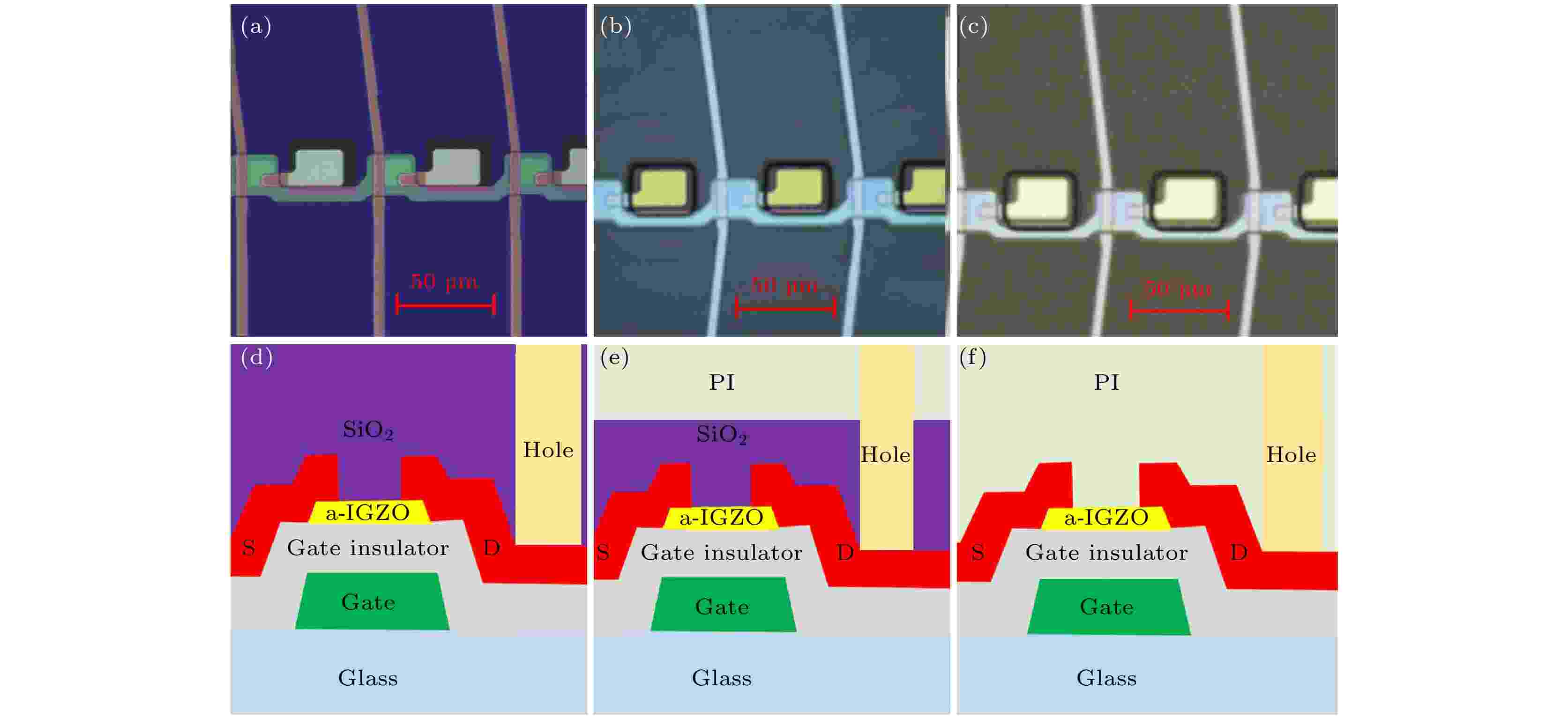
2023, 72 (8): 087302.
doi: 10.7498/aps.72.20222272
Abstract +
Amorphous indium gallium zinc oxide (IGZO) thin film transistors (TFT) are widely used in active-matrix displays because of their excellent stability, low off-current, high field-effect mobility, and good process compatibility. Among IGZO TFT device structures, back channel etching (BCE) is favorable due to low production cost, short channel length and small SD-to-gate capacitance. In this work, prepared are the BCE IGZO TFTs each with the passivation layer of silicon dioxide (SiO2), polyimide (PI) or SiO2-PI stacked structure to study their difference in back channel hydrogen impurity and diffusion behavior. Comparing with the conventional SiO2 passivation BCE TFT, the performance of PI passivation TFT is improved greatly, specifically, the saturation field effect mobility increases from 4.7 to 22.4 cm2/(V·s), subthreshold swing decreases from 1.6 to 0.28 V/decade, and the an on-off current ratio rises dramatically from 1.1×107 to 1.5×1010. After the SiO2 passivation layer is substituted with PI, the I off decreases from 10–11 A to 10–14 A, which indicates that there exist less shallow-level donor states of hydrogen impurities, which might be explained by the following three mechanisms: first, in the film formation process of PI, the direct incorporation of hydrogen-related radicals from SiH4 precursor into the back channel is avoided; second, the hydrogen content in the PI film is lower and harder to diffuse into the back channel; third, the hydrogen impurity of back channel that is introduced by the H2O2-based etchant in the SD etching process could diffuse more easily toward the PI layer. The TFTs with PI passivation layer also shows the less electrical degradation after the annealing treatment at 380 ℃ and better output performance, which confirms less defects and higher quality of the back channel. The bias stabilities of PI devices are improved comprehensively, especially negative bias illumination stability with the threshold voltage shifting from –4.8 V to –0.7 V, which might be attributed to the disappearance of hydrogen interstitial sites and hydrogen vacancies that are charged positively in the back channel. The PI passivation layer is effective to avoid back channel hydrogen impurities of BCE TFT and promises to have broad applications in the display industry.
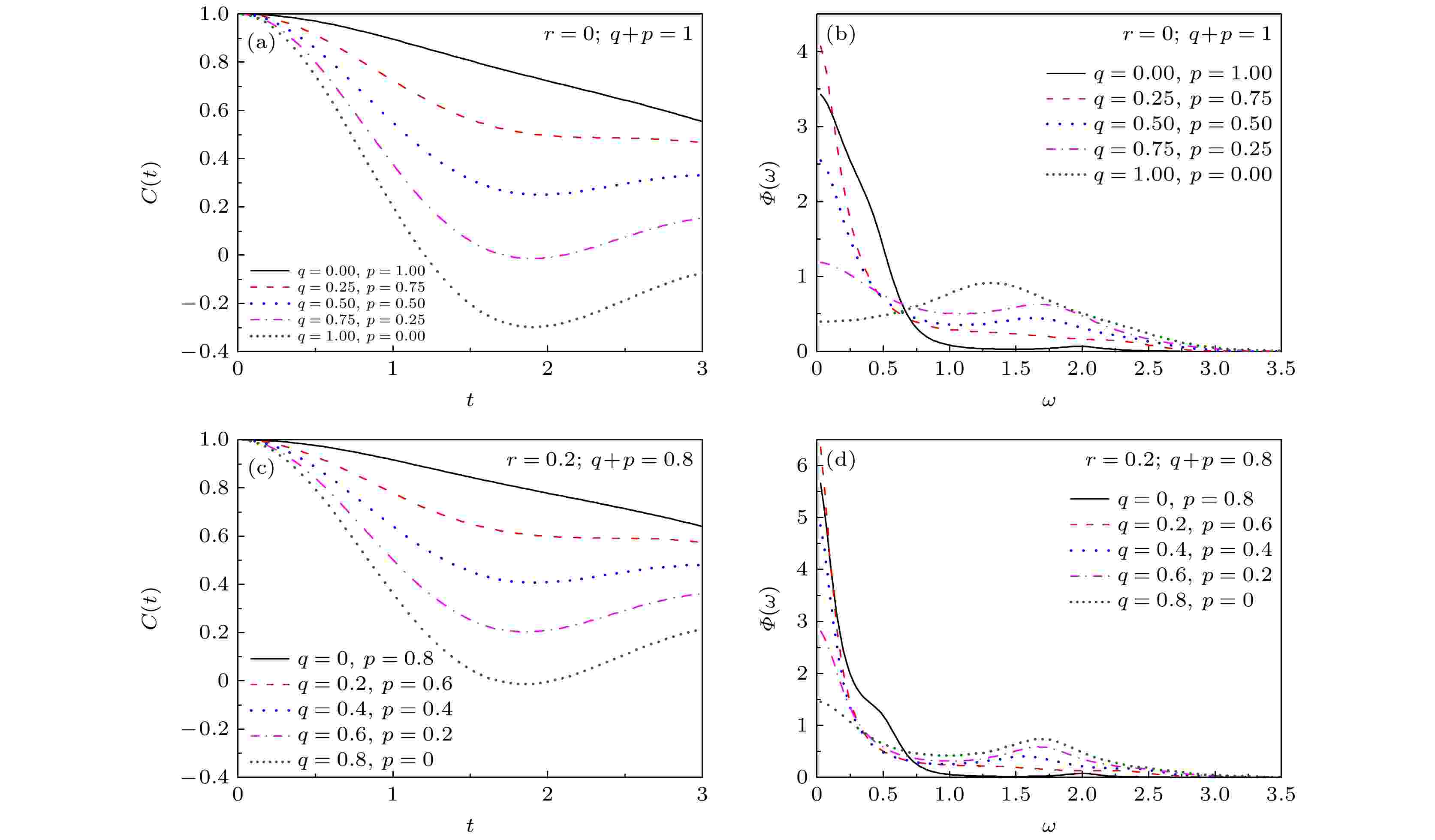
EDITOR'S SUGGESTION
2023, 72 (8): 087501.
doi: 10.7498/aps.72.20230046
Abstract +

COVER ARTICLE
2023, 72 (8): 087801.
doi: 10.7498/aps.72.20230039
Abstract +
High-precision spectra of Rydberg atoms are of significance in studying the interaction between Rydberg atoms, the energy level structure of Rydberg atom, and the precision measurement of the electromagnetic field. To enhance the measurement sensitivity, it is necessary to achieve the high contrast, high signal-to-noise ratio, and narrow linewidth of the spectra of the Rydberg atoms. In this work, the cavity-enhanced spectra of Rydberg atoms are studied theoretically and experimentally. Comparing with the free-space spectra of Rydberg atoms, the contrast and the signal-to-noise ratio are enhanced by 11.5 times, with the linewidth unchanged. Under the condition of two-photon resonance, both the electro-magnetically induced transparency and the double-resonance optical-pumping process can suppress the absorption of the probe laser, thereby improving the impedance matching of the cavity. As the intracavity probe laser intensity turns stronger, the contrast and signal-to-noise ratio can be improved further, and the improvement depends on the transmission of the probe laser through the atom vapor. It is expected that the contrast and signal-to-noise ratio can be improved by a factor of 23 through optimizing the temperature of the cesium atom vapor. This work provides an important reference for improving the contrast of the spectra of Rydberg atoms and the sensitivity of Rydberg-based precision measurements.
INTERDISCIPLINARY PHYSICS AND RELATED AREAS OF SCIENCE AND TECHNOLOGY
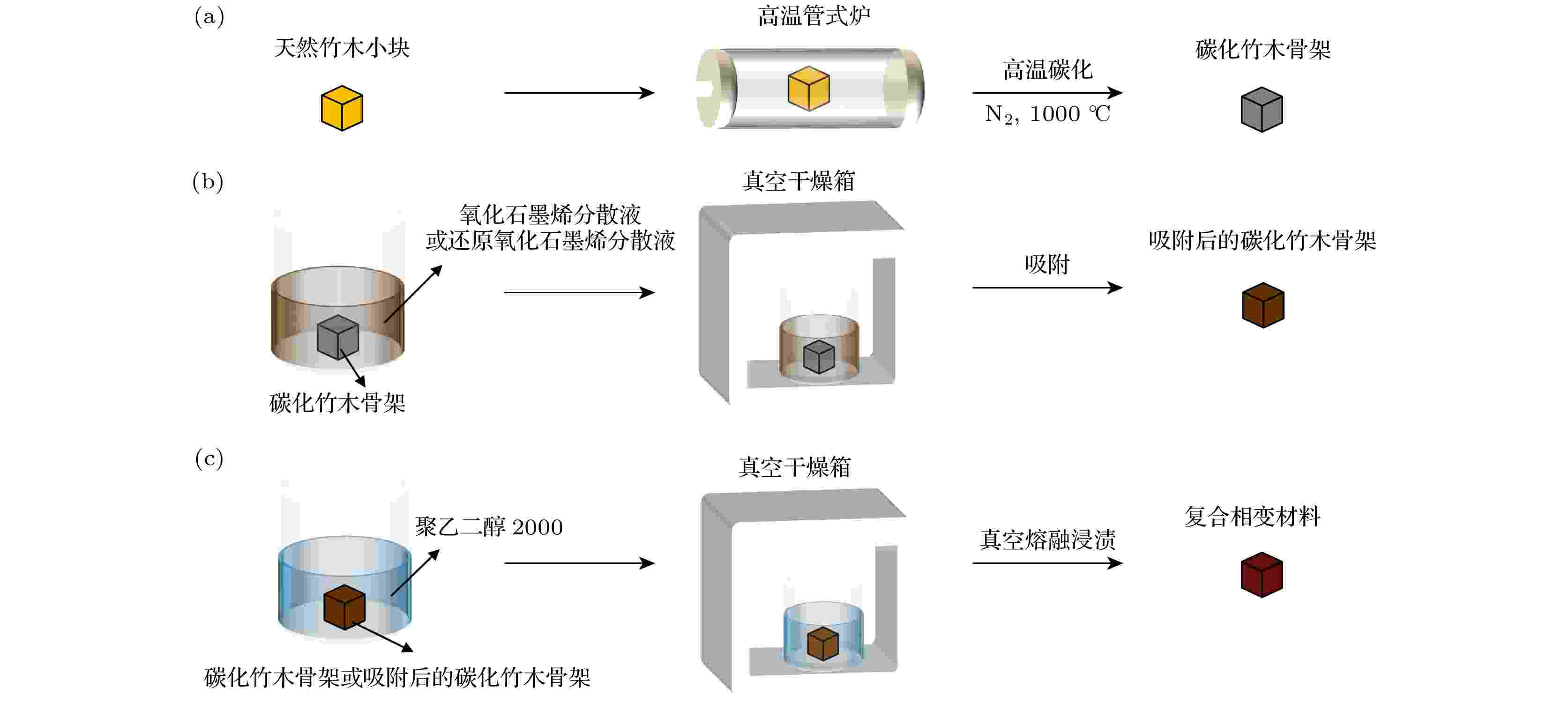
2023, 72 (8): 088801.
doi: 10.7498/aps.72.20222466
Abstract +
Thermal energy storage technology can shift the peak and fill the valley of heat, which lays the foundation for realizing the goal of “emission peak and carbon neutrality”. Among various thermal energy storage techniques, the latent heat storage technology based on composite phase change materials can provide large storage capacity with a small temperature variation, and shows great potential in solving the intermittency issue of renewable energy. As a sustainable and renewable material, natural wood has the advantages of a unique anisotropic three-dimensional structure, perfect natural channel, low price, and rich resources. Therefore, the carbonized wood obtained from high-temperature carbonization of natural wood is an excellent choice as a supporting skeleton of composite phase change materials. On the other hand, polyethylene glycol is widely used in energy storage because of its suitable phase transition temperature (46–65℃), high latent heat (145–175 J/g), and stable performance. In this study, carbonized bamboo is prepared at high temperatures. To improve heat storage, thermal conductivity, and photo-thermal conversion properties, the carbonized bamboo is functionalized by graphene oxide and reduced graphene oxide, respectively. Finally, polyethylene glycol is implanted into modified carbonized bamboo to form shape-stabilized phase change materials. Their microstructures, morphologies, and thermophysical properties are characterized. The experimental results show that graphene oxide and reduced graphene oxide can change the surface polarity of carbonized bamboo, thus reducing the interfacial thermal resistance between the carbonized bamboo skeleton and polyethylene glycol, and improving the encapsulation ratio, thermal conductivity, and photo-thermal conversion efficiency without affecting the crystallization behavior of polyethylene glycol. The encapsulation ratio of carbonized bamboo/reduced graphene oxide/polyethylene glycol ternary phase change material is as high as 81.11% (only 4.67% lower than the theoretical value), its latent heat of melting and solidification are 115.62 J/g and 104.39 J/g, its thermal conductivity is greatly increased to 1.09 W/(m·K) (3.7 times that of pure polyethylene glycol), accompanied by substantial growth in its photo-thermal conversion efficiency, reaching 88.35% (3.1 times that of pure polyethylene glycol). This research develops a biomass-derived porous composite phase change material with high heat storage density, high heat transfer rate, and high photo-thermal conversion ability.

2023, 72 (8): 088802.
doi: 10.7498/aps.72.20230105
Abstract +
Efficient copper based thin film solar cells usually use inorganic n-type semiconductor material CdS as the buffer layer. Therefore, the interface quality and energy band matching between the buffer layer and the absorption layer are crucial to the collection and utilization of carriers. Heat treatment can promote the mutual diffusion of interface elements, the migration of ions in the material, and the change of defect state, and the appropriate temperature will change the Cu-Zn ordering degree in the absorption layer, so as to improve the efficiency of the solar cells. Based on the optimization of CdS basic process, the strategy of annealing CdS/copper-based thin film heterojunction in sulfur atmosphere further improves the quality of CdS thin film, and is applied to copper-based solar cells to regulate the p-n heterojunction energy band gap matching of copper-based thin film cells. The results show that the annealing of CdS thin film in sulfur-containing inert atmosphere can effectively improve the crystal quality of CdS thin film and inhibit the non-radiative recombination loss caused by defect trapping at the interface of CZTS/CdS heterojunction, and the open-circuit voltage of the device can significantly increase to 718 mV. In addition, annealing CZTS/CdS heterojunction in S/Ar atmosphere can effectively improve the p-n heterojunction energy band gap matching, which not only improves the electron transmission, but also reduces the carrier recombination, thus improving the Voc and FF of the device. Besides, the oxygen element in CdS film can be replaced by sulfur element in sulfur atmosphere to improve the quality of CdS film, and thus enhancing the short-wave absorption of solar cell device. Therefore, in terms of device efficiency, the efficiency of CZTS solar cell based on sputtering method increases from 3.47% to 5.68%, which is about twice that of non-annealing treatment. Its device structure is Glass/Mo/CZTS/CdS/i-ZnO/Al:ZnO/Ni/Al, providing a reliable process window for copper based thin film solar cell devices to achieve high open-circuit voltage. Meanwhile, this study strongly demonstrates the importance of annealing atmosphere selection for CdS quality and energy band matching of CZTS/CdS heterojunction. In addition to interface interdiffusion, the composition and crystallinity of thin film material are controlled.
GEOPHYSICS, ASTRONOMY, AND ASTROPHYSICS
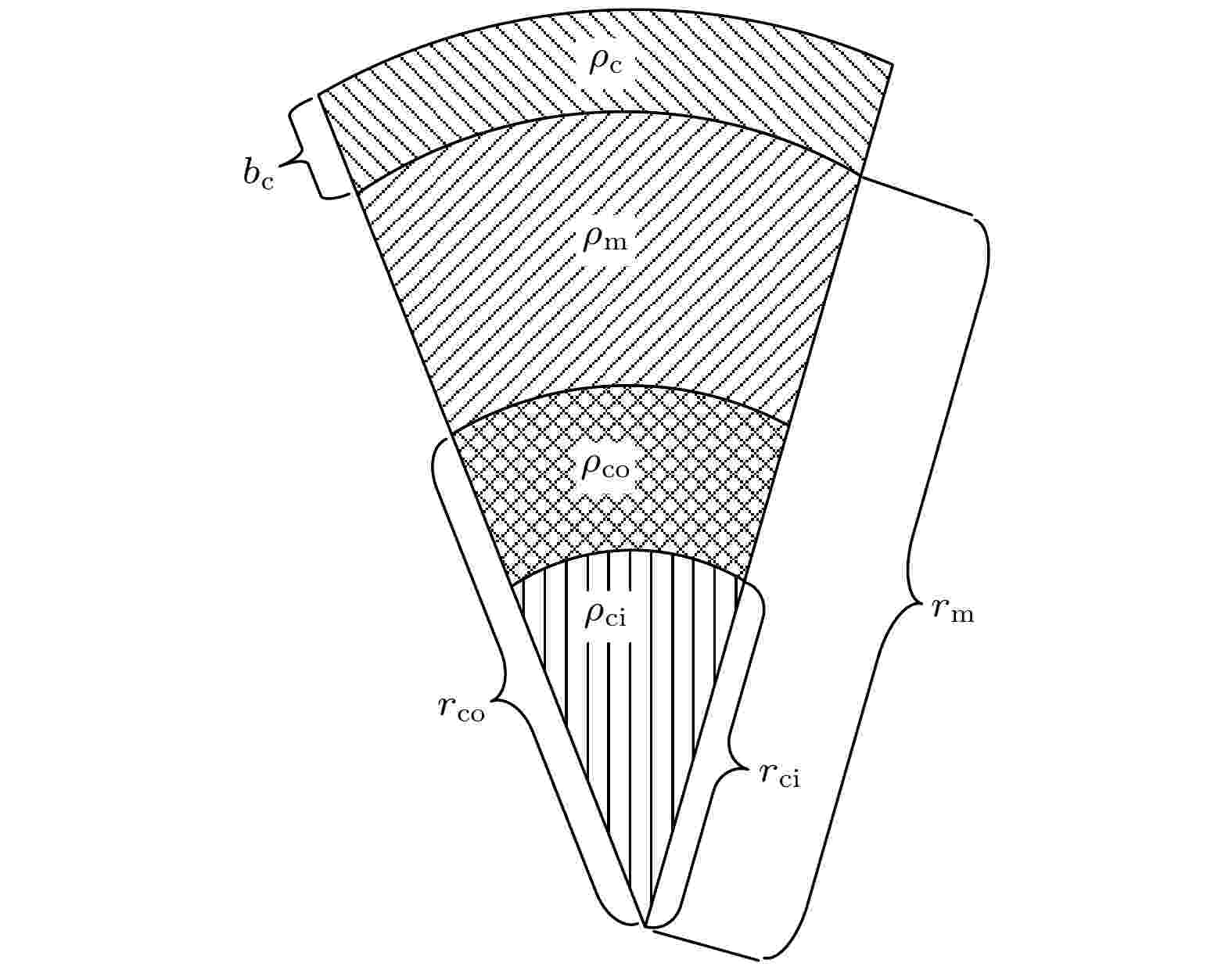
EDITOR'S SUGGESTION
2023, 72 (8): 089601.
doi: 10.7498/aps.72.20222282
Abstract +
This study focuses on the size of composition of lunar core. In this study, we consider the lunar mean density and mean moment of inertia factor in our inversion. We use the degree-2 coefficients of lunar gravity field model GL990D and the lunar physical liberation parameters to compute mean moment of inertia factor, which is treated as an observed value. We also compute the observed value of the mean density according to the total mass of the Moon. Based on the interior structure with various layers, we deduce the modeled expressions for the lunar mean density and mean moment of inertia factor. Summing the squares of the difference between the observed value and modeled value as an inversion criterion, we estimate the multi-parameters based on the simulated annealing algorithm. By considering the lunar interior structure with three layers, the estimated size of the lunar core is around 470 km, and the density of the core is close to 5486 kg·m–3. The computed size and density of the lunar core are close to other reported values, thereby validating our algorithm. We then consider the scenarios that the lunar core differentiates between a solid inner core and a liquid outer core. The good-inversed outer core is close to 385 km, while the inner core approaches to 350 km. By using the good-inversed sizes as fixed parameters, it is found that the inner core reaches 7879 kg⋅m–³, quite denser than the outer core, which is estimated at 4618 kg⋅m–³. Our result indicates that the outer core is composed of ferrous sulfide (FeS), while the inner core is comprised of ferrous or ferro-nickel, formed 3.56 billion years ago when the lunar core dynamo ended.










































